The Book Store Is Now Open

Therefore, based on some of our recent discussions, I have created a customized page with some of the Bibles I am currently using: "Rick's Bible Tool Belt." And I also created a filtered book page using "wide margin bible" as my filter. If I could customize this page, I would make it match the offerings in the wide-margin Bible survey that I posted a couple of weeks back.
Then I tried to create a software page using the keyword "Accordance," but all the bundles Amazon had said "Currently Unavailable" [Hello, David Lang!!]. Plus my test page also displayed modules from Logos Bible Software. I wanted Accordance, not Logos!
The ability to create more than one customized page would be nice as well as the ability to have more than one filtered category page. However, it is only a beta program right now, and for what it does, it does fairly well.
And of course, yes, if you order something from my page, I DO get a cut. But it's a very minor cut, and you'd be helping out this poor seminary student. So, thanks!
Quote for the Day #11: The Unpardonable Sin: Swearing from the Pulpit
David Jenkins, the former Bishop of Durham, argued against the physical resurrection of Jesus, the literal truth of the Bible, and the continued existence of his own Church of England. But it wasn't until he used the words "bloody" and "damn" in a sermon that he got banned from two area churches. Ah, priorities.
What Bibles Are People Really Buying?
Here's what I now know thanks to a knowledgeable, but (for your purposes) unnamed source:
• Contrary to my speculation below, CBA stores as a whole do indeed outsell Amazon by a healthy margin (I just thought everyone bought from Amazon like me).
• Bibles with the apocrypha sell better on Amazon because they can't be as easily bought in physical stores, especially CBA stores.
• Contrary to one of my conclusions below, the NRSV is not quite as healthy as perhaps I thought after initially looking at Amazon's results. Evidently, it is just easier to obtain through Amazon than other sources. Unfortunately, many editions of the NRSV have gone out of print and its use as a translation is on the decline.
• I was at least correct on one count--study Bibles do indeed outsell text Bibles. Surely this is a change in practice from a generation ago.
I could easily just remove this post, but regardless of the error in some of my conclusions and speculations, the information by itself is still fairly interesting. Plus, I don't mind admitting when I err.
Therefore, I am leaving the post as is. Enjoy.
There are five separate Bible bestseller lists in this blog entry. Only the last one may have any real significance.
What BIbles are people buying these days? This is a difficult question to answer because as far as I know Bible publishers don't report their sales figures to one central source that keeps track of such things.
Zondervan may be the only Bible publisher I know to release it's own list of top-selling Bibles. Here's the list as it stands today:
Zondervan Top Sellers
1. NIV Life Application Study Bible
2. NIV Audio Bible Dramatized CD
3. NIV Study Bible
4. NIV Teen Study Bible
5. NIV Adventure Bible, Revised
6. NIV Student Bible
7. TNIV True Identity
8. TNIV Pocket Bible
9. NIV/The Message® Parallel Bible
10. NIV Thinline Reference Bible
Zondervan's list is interesting, but we still don't know how its sales compare with other Bible publishers.
There's always the CBA bestseller lists, but as I've suggested before, these figures aren't overly representative of all BIbles sold. They leave out secular stores like Borders and Barnes & Noble. They leave out a number of Catholic and Jewish sources. And certainly, the most significant numbers that are left out are those of Amazon.com. The CBA numbers end up looking surprisingly Evangelical because they don't really adequately measure non-Evangelical sources which for the most part are non CBA stores.
Look for example at some of the CBA's recent best sellers for August (which actually means for July):
Specialty Bibles (whatever that is)
1. Cornerstone Reference Bible (KJV)
2. NIV Thinline Bible (NIV)
3. Spanish Reina Valera 1960 Outreach Edition (RVR)
4. Men's Devotional Bible (NIV)
5. Women's Devotional Bible (NIV)
Study Bibles
1. The NIV Study Bible (NIV)
2. Life Application Study Bible (NIV)
3. Archaeological Study Bible (NIV)
4. KJV Study Bible (supersaver ed.) (KJV)
5. Life Application Study Bible (KJV)
Young Adult/Children's Bibles
1. The Adventure Bible (NIV)
2. The Student Bible (NIV)
3. The Teen Study Bible (NIV)
4. True Images (NIV)
5. The Adventure Bible for Young Readers (NIrV)
Okay, I wanted to list these above for sake of contrast with another source for determining bestselling Bibles: Amazon.com. I really wish I knew how Amazon's sales numbers compare with those of the CBA. My guess (and it's only a guess) is that Amazon by itself sells more Bibles than all CBA stores combined, but I have no way of proving that--it's just a hunch.
Here's what I did. At Amazon.com's home page, I did a simple search for "Bible." Once the results were shown, I narrowed my selection by clicking on "Books" on the left. Then I narrowed my results further by clicking on the "Religion and Spirituality" link. Finally, I narrowed them one step further by clicking on the link that said "Bibles and Other Sacred Texts" (I could have narrowed one category further by clicking on "Bible," but I didn't want to eliminate the category "Torah"). The very last step is to change the "Sort by" drop down to "Bestselling."
Now I had my results. Although there were still quite a few non-Bible hits, it didn't take much effort to wade through to see what Bibles people were actually buying off of Amazon.com. The results may surprise you. I was certainly surprised by some of them.
AMAZON.COM'S CURRENT TOP SELLING BIBLES
1. The New Oxford Annotated Bible, NRSV with the Apocrypha, Third Edition (ISBN 019528478X)
2. The Catholic Youth Bible, NAB (ISBN: 088489794X)
3. The Archaeological Study Bible, NIV (ISBN: 031092605X)
4. Fireside Catholic Bibles: School and Church Edition, NAB (ISBN: 1556654901)
5. The Harper Collins Study Bible, NRSV with Apocrypha (ISBN: 0060655275)
6. The Message Remix (ISBN: 1576834344)
7. The New Interpreter's Study Bible, NRSV with Apocrypha (ISBN: 0687278325)
8. The Jewish Study Bible featuring the JPS TANAKH Translation (ISBN 0195297512)
9. Life Application Study Bible, NIV (ISBN: 0842348921)
10. Zondervan NIV Study Bible, Personal Size (ISBN: 0310923077)
In my opinion, the above list may be a more accurate list than anything else out there. Further, it's a very fluid list and could change at any moment as people make actual purchases. There are a number of interesting observations I could make about the above list.
First, note the stark predominance of study Bibles over text Bibles. The Message/Remix is a text Bible, and I'm not certain about the Fireside Catholic Bible, although I would presume the latter would include the NAB notes.
Second in spite of reports to the contrary, and in confirmation with my own findings when I posted on top blogged translations, the NRSV is far from dead. In fact, it's very well alive. Three of the top 10 are NRSV and if I had gone further, to the top 20, there would be even more listed including the Renovaré Spiritual Formations Bible.
Third, although the Jewish population makes up less than 5% of the population, I was very intrigued to see The Jewish Study BIble come in at #8, ahead of both the NIV Application Study Bible and the NIV Study Bible. If you're curious, the BHS came in at #13. Don't let anyone tell you that Judaism is not alive in well when it comes to study of the Scriptures.
Fourth, despite the fact that all of these Bibles will find some use outside their target audience, the selection essentially breaks down to 40% Evangelical and 60% non-Evangelical. Don't let anyone tell you that only Evangelicals are reading their Bibles. Here's a different way of looking at it: NRSV 30%, NIV 30%, NAB 20%, The Message 10%, and JPS 10%.
Sixth, 50% of the Bibles above include the Apocrypha. Evidently the debate over the limits of the Canon are not quite yet over.
Seventh, notice the absence of a number of newer translations including the NLT, ESV, HCSB, and TNIV.
Finally, just because something is on a bestseller list, doesn't mean that it's a quality selection. Look at any of the books on today's fiction or nonfiction bestsellers list and that becomes evident. However, if I had begun to list what I thought was a "popular" representation of Bibles being sold today, my list would have looked very different from the one above. Certainly, someone might say, "Well just because people are buying Bibles, doesn't mean they are reading them." Well, that's true. But if people were just buying Bibles to have in their homes or to carry to church and not really to read, I would have expected a lot of thinline Bibles and pocket and purse Bibles. With minor exception, the Bibles listed above are meant for serious study.
Surprising indeed.
NIV Wide-Margins on the Cheap
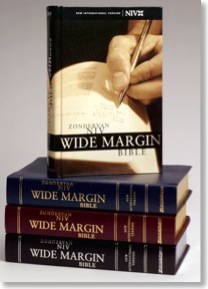
You can even choose which color you want: black, burgundy, or navy blue.
For those of you who like hardbacks, the NIV Wide Margin is only $22.99, although Amazon has it cheaper at $19.79.
Since CBD is known for making exceptional deals on items they often get as remainders, it makes for interesting speculation as to whether or not Zondervan is planning new editions of the NIV Wide Margin Bible. But who knows--maybe they're just overstocked. As I've said before, I'm still holding out for a TNIV Wide Margin Bible. Yesterday, I sent a link to my blog entry on what I want in a wide-margin Bible directly to Zondervan on their contacts page. I also suggested that they look at all the comments on that entry from all of you. So hopefully, they're listening.
Also, a few weeks back I reported that CBD had NLT1 Notemaker's Bibles on the cheap for $17.99. They've now dropped their black and burgundy bonded leather editions down to $12.99 and the hardback is $7.99. Holy frijoles!
Mellel 2.1 Released
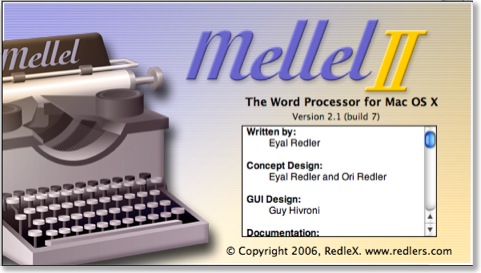
I was fortunate enough to be privy to the beta builds over the last two or three weeks, so don't let the ".1" designation fool you--Mellel 2.1 is a major release. If you've got a Mac and you're engaged in academic writing, especially writing that incorporates foreign languages such as Greek and Hebrew, this is the word processor you need. Even the upcoming version of Word for the Mac will still be unable to allow you to enter right to left text for a language such as Hebrew.
From the Redler's press release a few hours ago:
For Immediate Release
Mellel 2.1 introduces XML format, superb find and replace, full screen mode, and more
Tel Aviv, Israel — August 28, 2006 —RedleX today released Mellel 2.1, a major update to the leading word processor for Mac OS X. Mellel 2.1 introduces several key important changes and features, including switching the file format to XML, top notch Find and Replace capabilities (full Regular Expressions support), Full screen mode, paragraph and character style palettes, and much more.
The update is free to all registered users of Mellel. The update is a for-pay upgrade for user who purchased Mellel more than 3 years ago. A free trial version is also available.
The most important change in Mellel 2.1 is the move to XML based file format. With this move, which took several months to implement, Mellel is moving to an open, standard, text based file format, that is much more economic in terms of file size, and opening the door to a slew of innovative options for formatting, import and export.
"The move to XML is important for many of our users because it frees them from any future worries," says Eyal Redler, CTO at RedleX. "XML-based file format are becoming the standard in word processing. Just about every serious word processor is moving in that direction or is already there. In addition, text in XML-based files will always be retrievable and easy to script and manipulate by Mellel, AppleScript or any other application," he adds. The new XML-based format will also make it easy to convert Mellel files to and from other XML-based formats such as those used by MS Word, Pages, FrameMaker, and more.
Another important in Mellel 2.1 is the completely rewritten Find and Replace feature, including full support for Regular Expressions (RegEx), find and replace by character formatting and styles, flexible search options, and more. "Regular Expressions is an insanely great, extremely powerful tool, but for most of the users it is completely useless, because it is simply too complex," says Guy Hivroni, cofounder and chief GUI designer for Mellel. "With Mellel's new Find and Replace we tried to make RegEx useful to mere mortals. No more cryptic codes, carets, slashes, asterisks, and so on. Everything is icon driven and clear, so even non-programmers-types can make use of it."
Mellel 2.1 is available for download now, from the servers listed below. The price for a single user license is US$49, Educational license is US$34.99, 5 Pack license (5 separate licenses) are US$99. A Boxed Edition of Mellel is also available for US$59 (including shipping costs).
For a complete of new features, improvements and bug fixes, please see the release notes at: http://www.mellel.com/releasenotes.html
Main New Features
- XML: Mellel 2.1 uses an XML-based file format, shrinking file size by up to 400 percent. The format is clear and cleanly separates content from formatting, making it easy to write convertors and otherwise manipulate files.
- New Find and Replace: Mellel's new Find and Replace option fully supports Regular Expressions, but with a much friendlier interface.
- Find by formatting and style: Mellel now supports find and replace by formatting and style.
- Full Screen mode: allowing you to move into full screen mode (no menus, palettes, window frames, etc.) which is WYSIWYG and zoomable.
- Find Expressions and Find Actions: You can now save expressions you've created and complete find action, and "play" them later on.
- FindSets: Allowing you to create sets of Find Action you can run all at once, completely formatting or reformatting a document in a matter of seconds.
- Paragraph Style palette: Offering you control over applying, creating, editing, saving, and deleting paragraph style.
- Character Style palette: Offering you control over applying, creating, editing, saving, and deleting character style.
- Equation editing round-trip: Mellel now support round-trip editing of equations created in MathMagic. The equation is kept "alive" and editable in MathMagic.
- Auto-title in-place editing: You can now edit auto-titles in-place.
• Mellel 2.0 Released
• Mellel Roadmap
• It's Official: No Right-to-Left Text in Word 12 and Why I'm Switching to Mellel
Is Belief in God Good, Bad or Irrelevant?
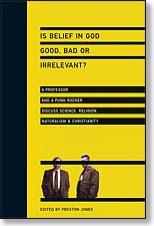
I've read lots of "conversations" between Christians and non-Christians, but I was always troubled that the Christian in the books was so easily able to destroy the arguments of the skeptic as this never seemed to work quite so easily for me in real life. The problem is that in the books, such conversations are usually made up, and of course, the Christian gets the edge. That's not the case with the conversation between Preston Jones and Greg Graffin in the new book Is Belief in God Good, Bad or Irrelevant? from InterVarsity Press.
In this book, we get to read a read another person's email--in fact the email of two people--and it's perfectly okay. The book is described as "A Christian and a naturalist in conversation," and that's exactly what it is. What makes the book so interesting is who these two people are. Representing Christianity is Preston Jones who is a professor of history at John Brown University in Siloam Springs, Arkansas. His naturalist counterpart is Greg Graffin. Now if Graffin's name sounds vaguely familiar to you, it's because he's lead singer of Bad Religion, a punk group whose lyrics tend to be not just anti-Christian, but anti-religion in general. What I didn't know about Graffin until this book is that he has a Ph.D in evolutionary paleontology from Cornell University. Yes, you read that correctly. His dissertation was titled, "Monism, Atheism and the Naturalist Worldview: Perspectives from Evolutionary Biology."
Jones' and Graffin's email correspondence makes for very thought-provoking reading. The book is not a primer in evangelizing the lost as some may be tempted to think, but rather an open-ended dialogue between one person who sees value in religion and another person who doesn't. Neither is converted to the other's opinion by the end of the book, but it is the conversation itself that is of most value.
I should also point out that although Jones initiated the conversation, his writing never makes Graffin come across as an evangelism project. In fact, Jones was a fan of Bad Religion from its very early days in the early 1980's. Since Jones genuinely appreciated the honesty of Graffin's music, his impulse one day to send Graffin an email was done with the utmost respect for the man.
What is contained in the book is an extended conversation that takes place over a a period months, mostly in 2003. While the messages are kept in chronological order, certain themes emerge that form the sections of the book. This won't seem unusual to you if you've ever kept a long-running conversation going with someone through any means of correspondence. Although the conversation is forward going, the topics wax and wane. This is certainly true for this book. The table of contents list a number of conversations including the following: religious inquisitions, hating God, theism vs. naturalism, foundations for morality, the Fall, free will (Graffin does not believe in free will of any kind), Christianity and violence, and proximate vs. ultimate meaning. Other topics are covered as well.
The book also contains a series of intelligent study guides. I call them "intelligent" because these guides are not afraid to ask hard questions regardless of whether one is a theist or naturalist. Further, each study guide comes with research questions which will take a fair amount of preparation on the part of the participants. This is definitely not designed for a "show up and talk about it" group.
The book is a good "get out of your comfort zone" read. As I said, neither person converted the other to his point of view, but I have no doubt the conversation may be ongoing. What is of value is that certain stereotypes about the other's position may by have been dismantled for both participants. Surely Graffin came to realize in his discussions with Jones that there actually are intelligent Christians out there who can hold legitimate conversations about faith, biology, and naturalism. And no doubt Jones was stretched by Graffin as many of his arguments were countered one-by-one.
If there is any evangelistic value to this book, it is to show that to gain an audience with some non-believers, one has to show genuine respect and be willing to communicate openly, honestly and (most importantly) intelligently over the long haul. There is no room for hit and run, cold-turkey evangelism with someone like Graffin. Those are the kind of folks he philosophically and intellectually eats for breakfast.
Quote for the Day #10: The Easy Life of a Pastor
D. A. Carson and John Woodbridge, Letters Along the Way: A Novel of the Christian Life
Wisdom from My Fortune Cookie #5
Inconsistency

The question is this: Why is the NLT okay, but not the TNIV?
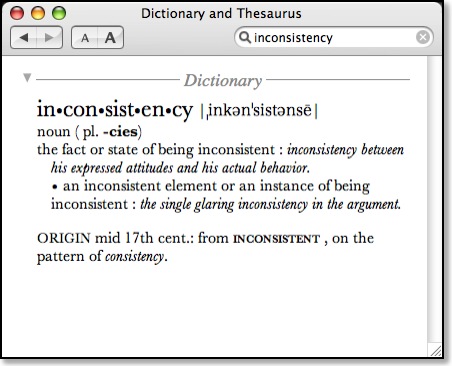
Follow-Up to the Mississippi Church Racial Controversy
First, The Northeast Mississippi Daily Journal pulled the story from their website late yesterday. This Lamp reader (and my former student!) Josh Clark took it upon himself to contact the newspaper to inquire why the story was no longer online. Here is the response he received:
It's interesting that the paper would claim that the story only "appeared for a few minutes on our site." I first discovered the story around 2 PM Thursday on the Christianity Today Weblog. It was certainly still online when I posted the story 13 hours later here on my blog. I was unaware the story had been pulled until This Lamp reader Rae Whitlock noted in the comments of yesterday's post that the link was broken. I'm not exactly sure how long the story was on the Daily Journal's website, but I know that it was there for at least 24 hours. However, considering the original article is dated August 19, I want to assume that it may have been online for the better part of an entire week.The article linked to was not supposed to be for publication. It appeared for a few minutes on our site, but it never appeared in print. The writer and her editor decided not to publish the story for lack of comments from the church, but they failed to inform us on the online side it had been killed. The reporter has asked Christianity Today's web site to pull the segment about her story, but was told it could not do it until this weekend.
A more thorough version of the story will be published in Saturday's Daily Journal.
Second, now the story is back up in an expanded version at the original link (see "Pastor Claims Church Voted to Reject Black Membership, Resigns"). Regarding the content, the only piece of new information is an official denial from the church that the vote ever took place. This turn of events is not overly surprising as denial is usually the first response to accusation. And with the pastor gone, it becomes a "your word against ours" conflict. Pardon my bent for mischief, but the church's denial could easily be tested if a large group of the community's non-white population were to show up as visitors to tomorrow's service. Such a move might be a good way to peacefully protest the church's racial attitudes anyway.
Assuming that this story is true (I've yet to see anything to really suggest that it is not, and this is confirmed by the Daily Journal's attempt to handle it delicately), I hope that the central figure in this--the 12-year-old boy, Joe--is not forgotten.
I remember my own joy at becoming a follower of Christ. Everyone shook my hand; there were smiles and pats on my back. Even though I was a child, I felt like I had made a very grownup decision. My public profession of faith was followed by a class in church beliefs and then my baptism. I look back at that experience with fond memories. It was a very positive and life-changing experience.
But then I think of Joe. Years from now, will he look back at the time when he "accepted Jesus into his heart" (a quote from the original DJ article) with fondness or bitterness? I can't imagine that Joe would have any means to separate his decision to follow Christ from the chain of events that followed soon afterward.
“But whoever causes the downfall of one of these little ones who believe in Me—it would be better for him if a heavy millstone were hung around his neck and he were thrown into the sea."
(Mark 9:42 HCSB)
As tragic as the situation is, if years from now Joe is tempted to turn his back on his decision to follow Christ, I hope he will remember the other two individuals (and their families) who sacrificed their church membership with him. It can certainly be no small thing that a police officer--a leader and authority figure in the community--and more significantly, the pastor of the church himself chose to be excluded with Joe and his family rather than remain with a group whose actions demonstrated they were not worthy of the name, Christian.
As for Fellowship Baptist Church, God is not through with them yet...one way or another. A day will come when they have to answer for their actions
“Behold, I am going to deal at that time
With all your oppressors,
I will save the lame
And gather the outcast,
And I will turn their shame into praise and renown
In all the earth.”
(Zephaniah 3:19 NASB)
Final note (for now): History on the internet can be a tricky thing and too easily facts can be revised. Therefore I am attaching below two separate PDF files. The first contains the original story placed online by The Northeast Mississippi Daily Journal and the second document contains the revised article posted today. Here are the two files: djournal.20080819 and djournal.20080826.
Unbelievable in 2006: Baptist Church in Mississippi Votes Out 12-Year-Old Over RACE
In July the ironically named Fellowship Baptist Church in Saltillo, Mississippi, held revival services. During those revival services, 12-year-old Joe, a boy of biracial descent "accepted Jesus into his heart." On August 6, at the church's business meeting, the all-white congregation voted to exclude blacks from its services, including Joe because they did not want him to bring his family members to worship services.
Unbelievable. Stunningly unbelievable. I cannot come up with strong enough words to describe my feelings for this church's decision. Such actions are nothing less than antichrist in the truest sense of the word.
The only bright spot in the entire event is that the church's pastor, Rev. John Stevens took a stand and chose to resign that very night rather than stay another day in service to a racist church. One other family, that of a Tupelo police officer, also left the small church that averages about 30 members. According to the Christianity Today Weblog, this story is surprisingly getting very little attention from the press so far.
I encourage you to read the full story "Pastor Leaves After Church Turns Away Biracial Boy" from the Northeast Mississippi Daily Journal. [Note: the link to the news story now points to a revised version and not the original one I referenced when I wrote this blog entry. For more information and access to both versions of the story, see my follow-up blog entry.]
Lest anyone forget, let me remind everyone right now that there is no room for racial division at the cross of Jesus Christ. Galatians 3:28 says ,
In Christ’s family there can be no division into Jew and non-Jew, slave and free, male and female. Among us you are all equal. That is, we are all in a common relationship with Jesus Christ.
(The Message)
Fellowship Baptist Church is aligned with the Baptist Missionary Alliance. Unfortunately, I do not know any of this denomination's distinctive beliefs. However I am glad to say that my own denomination, the Southern Baptist Convention is officially opposed to all forms of racism. Article IX of The Baptist Faith and Message, "The Christian and Social Order," clearly states that "In the spirit of Christ, Christians should oppose racism...." That doesn't mean that we merely say we are against racism; it means that Southern Baptists are called to take an active role to counter racism wherever it appears.
If the Baptist Missionary Alliance has any similar beliefs against racism (and they certainly ought to), then Fellowship Baptist Church should be DISfellowshipped.
Redacted 8/26, 11:30 AM.
Related Reading: "Follow-Up to the Mississippi Church Racial Controversy"
Somebody Get an Anvil!

I understand that there is a need to explain our culture and our heritage to children, and to make sure they understand it in the proper context. That includes cartoons. Cartoon Network did a special a couple of years ago that looked at Japanese racism in World War II cartoons, including racist slang and mentioning interment camps.
But come on…smoking? Tom and Jerry hit each other with frying pans, shovels, etc., set each other on fire, blow each other up, shoot at each other. They practice just about every form of cartoon violence possible. And this company is going to edit out smoking? Shouldn’t they be worried that children will be imitating some of Tom and Jerry’s other inappropriate behavior?
Furthermore, kids see smoking just about everywhere. Hollywood had a contract (written or unwritten) with the tobacco industry for years to show characters using cigarettes. Court documents have revealed that Joe Camel was especially created to get the youth market, and that tobacco advertising has been aimed toward children for years. Cutting it out of a cartoon, good intentions or not, is like putting a band-aid on a trauma wound.
But that’s not what really makes me mad. No, what is insane about this is that the company received a complaint from only ONE person. Not a group, not a bunch of people, just one person. A company caved in to one complaint.

I wish Chuck Jones and Tex Avery were still alive. They directed some of the best Tom and Jerry cartoons, and I bet they would have something wickedly funny to say about this. As it is, I hope their ghosts find all the people involved in this and drop anvils on their heads. But not before giving them a blindfold and one last puff of a cigarette (and I just know that some of you are going to criticize me for that comment).
Andrew Wells can be reached at arwell012002@yahoo.com.
This Lamp: SITE INDEX
Enjoy.
The M.G. Rhyming Revue...Review
The M.G. Rhyming Revue is a studio-produced, eclectic collection of songs based on nursery rhymes aimed more at adults than children. That's not to say that children wouldn't like these songs, but it will take an adult with life experience to fully appreciate them. The music is written, scored and produced by Philip Wade, minister of music at Cypress Baptist Church in Benton, Louisiana. Philip also provides the lead vocal on many of the tracks.
It's no secret that most Mother Goose (the source for the "M. G." in the title in case you missed it) nursery rhymes had their origin long ago in historical, often political contexts. But later they were reduced to quaint little poems removed from their original contexts and quoted over and over by preschool children. Perhaps their origin combined with an adult's familiar but ignored recollection of these rhymes makes them the perfect venue for exploring the complex grown-up world we now live in.
Consider the familiar rhyme about Jack and Jill, but with a twist:
Jack and Jill went up the hill to fetch a pail of water.
Jack fell down and broke his crown,
And Jill came tumbling after.
After all was said and done, Jack said, "This won't do."
They went on down to the county court and said,
"I think we'll sue!"
These words provide the beginning of the second song on the album, "Everybody's Got to Get Their Own." This song, which is performed in the style of a contemporary country and western ballad, explores the litigious society we live in and the desire to obtain wealth from any means possible. Unfortunately for Jack, he learns that often what goes around comes around, but I won't give away any more than that.
Here's a brief rundown of the rest of the tracks:
• "Be Quick" is based on the nursery rhyme "Jack Be Nimble" and gives advice to those who would be slow to commit in a romantic relationship.
• "Don't Be Afraid" borrows from "Little Miss Muffett" to explore the fear of the unknown.
• "Nothing More Than This" is a hopeful duet reminiscent of the songs in a better animated Disney movie. It is based on "Starlight, Star Bright."
• "Old Woman" uses "Old Mother Hubbard" as a basis to explore the stressful tasks that mothers of large families often face when they don't have enough help in the home.
• "Peter" is performed in the genre of Russian Cossack folk music. It explores the difficulty husbands often have understanding their wives' desire for emotional intimacy. It is adapted from "Peter, Peter, Pumpkin Eater."
• "Piggies," based on "This Little Pig Went to Market" encourages parents not to neglect the brief amount of time they have to influence children before they grow up and move away from home.
• "Wake Up!" is probably my favorite track. It is an a cappella rendition of "Little Boy Blue" that deals with laziness and procrastination.
• "You Can't Unbreak an Egg," as you might have guessed is based on "Humpty Dumpty." This song, done somewhat in the style of a march, examines the consequences of our decisions and taking responsibility for one's actions.
• "Only the Memories" is the sole non-nursery rhyme song in this collection. It's the kind of song that would be appropriately sung at a high school graduation. Perhaps it is featured last on the CD because it is a song about growing up and provides a bridge between childhood when we first learn these nursery rhymes and adulthood where we have to face life head-on and often learn hard lessons.
I recommend The M. G. Rhyming Revue to you. While many of the songs are fun, don't mistake this album as a collection of nursery rhyme spoofs. This is not "Weird Al Takes on Mother Goose," but a rather a clever attempt to take something from our distant fond memories and combine it with the realities of life. As I mentioned, children will enjoy these songs, too--so it's appropriate for the whole family--but only adults will catch the broader themes.
The M.G. Rhyming Revue is available from Big Shoe Enterprises for $16.99. Split tracks and piano/vocal scores are also available. At the website, you can also listen to samples from the songs.
My Personal Kobayashi Maru: Why Good Teaching Should Never Rely on Technology

I feel rather undressed without a lectern in a classroom or without a good solid pulpit in a church. (Do not give me a music stand! These contraptions cannot even support the weight of a good-sized Bible.) This affection for the lectern is not merely an idiosyncrasy on my part (I hope). The solid object from which a teacher or preacher speaks serves as the anchor for one’s notes, books, and articles. It provides a center point for engaging the class with the voice and the documents. Without a lectern, one loses this point of focus and gravity. One is reduced to standing directly in front of the class, perhaps holding one’s notes in one’s hand and grabbing a book off to the side once in a while. It is not good.
Why the disappearance of the lectern? Groothuis says it's the increasing dependance on PowerPoint for teaching. Teachers are keying in their notes on their laptops and teaching from presentation software. I've been teaching in one form or another--whether in high school or college classrooms, Bible studies at church or in homes, or occasionally behind a preacher's pulpit--for twenty years now. I'm no Luddite when it comes to technology--I use it quite a bit and am doing so simply to write this blog entry. But I agree with Groothuis that dependance on technology in teaching, or worse technology as a substitute for teaching is a mistake, and I'll tell you why.
Do you remember the Kobayashi Maru in Star Trek II: The Wrath of Khan? To prove that the Wikipedia has some good uses, let me quote from it in regard to the Kobayashi Maru:
In the Star Trek fictional universe, the Kobayashi Maru is a starship that serves as the subject of a graded training exercise at Starfleet Academy, in which command division cadets are presented with a no-win scenario as a test of character.
...
James T. Kirk takes the test three times while at Starfleet Academy. Prior to his third attempt, Kirk surreptitiously reprograms the simulator so that it is possible to win. He justifies it by arguing that putting cadets in a no-win situation was cheating, and so he had to cheat in return. He receives a commendation for original thinking.
Well, I had my own personal Kobayshi Maru when I was just starting out as a teacher. In 1990 I was finishing up my undergraduate degree in English Education. This involved 12 weeks of student teaching at the local public high school. Near the end of this experience, I was to be observed and evaluated by my supervisor at the university. She was not my original supervisor, but one who had been assigned to me near the end of my degree program and we had no real personal relationship with each other. All I knew of her was from her reputation--that she was tough, hard to please and could be unmerciful. She was known for making students repeat their student teaching experience.
Although this was 1990, I was already using a computer extensively in my preparation. I was the first student teacher to prepare all quizzes, tests, and handouts by computer--using MS Works for DOS, no less. Of course, I had to print everything in bold so that the results from a 24 pin dot matrix printer would copy successfully onto the purple ink of the ditto machine. And of course, because I had prepared a test on the computer, I could easily go back and correct mistakes as opposed to the documents that the older teachers used which were full of handwritten corrections and had been for the twenty or thirty years they used them because they didn't want to retype it on their typewriters. I impressed the teacher I was working under at the high school with my overhead transparencies. Overheads produced from typewriters were difficult to see. But using a computer I could actually raise the font to a legible size. This was well before PowerPoint became mainstream.
Near the end of my student teaching experience, my supervisor was scheduled to come and evaluate me. Everything was riding on this, so I had to do well. But i was less than hopeful. This was my kobiyashi maru--my seemingly unwinnable scenario. Why? Because this particular supervisor had a reputation for sabotaging her students simply to observe how they would react. She didn't care how well they could teach a lesson. She didn't care how much learning might actually be going on in a classroom. She just had some kind of sadistic desire to make her students squirm, and if possible, fail.
So, the night before my observation, I went through my entire lesson over and over again. I tried to think of various ways she could trip me up, and then I discovered the weakness in my own prepared lesson--a lesson, by the way, that I had to give to her in advance with a list of everything I would use to teach it. I had to ask myself what could happen that would possibly prevent me from being able to teach my lesson in the event of a worst case scenario. In asking that, I had my answer.
So as I began to teach my lesson the next morning, I went to turn on the overhead projector as I always did every class. But this time, the bulb didn't work. No light, and to make matters worse, my whole lesson revolved around that projector. I knew I had just changed that bulb the week before. Further, there's always an extra bulb inside the projector. But when I looked inside, it was missing. My she-demon supervisor thought she had me. I didn't dare make eye contact with her. I didn't want to see what I assumed to be a smirk across her lips or the glow of her devil horns.
Instead, very cooly, I reached down to the lower shelf of the projector stand and pulled out a stack of papers. I said to the class, "Well, I didn't want to give you this until the end of class, but since the projector isn't working, you may look on the handout I've made for you that has the exact same information as my overhead.

I learned a valuable lesson that day: never depend on technology for my lesson.
And I've learned to ask this most important question: Can I still teach my lesson if my technology fails?
It's not to say that I don't use technology in the classroom. I use technology to type my lessons, but I always print them out to have them with me, and I simply prefer to teach from paper than from a computer screen. Yes, I will use PowerPoint (technically I now use Keynote), but I never let presentation software drive my lesson. It is a tool to aid my discussion; it is not the basis for the discussion itself.
Over the years I have experimented with placing my lessons on a PalmPilot or teaching from the notes view in PowerPoint, but I've never stuck with these methods beyond trying them for curiosity's sake because they don't meet the qualification of my question in bold above. The visuals that presentation software allows me to use are fantastic, and I take advantage of it. However, I never let it become the focus of what I'm doing. I can teach with my notes and the ability to engage my students in discussion and create a better learning atmosphere than a PowerPoint-based lesson any day.
Since the dawn of the computer in the classroom, I've seen professors waste valuable class time because they couldn't get their laptops to "talk" with the projector. I've known of professors to cancel class altogether simply because a projector bulb was out. It's absolutely shameful to the profession to waste the students' time like that. But if everything is dependent upon the technology, what else can they do?
I've walked out of the house with my PowerBook on my shoulder only to have the strap break and have the computer come crashing to the ground. I had the same iBook in for repairs twice because of that in 2001. If I had all my notes exclusively on that computer, I would have been in a real mess. Laptops can break, Palm screens can crack, and projector bulbs can go out. But can I still teach if my technology fails?
The problem with computers is they offer to do everything for us. Yet, when they decide not to work, it leaves us without the ability to go back and do things the way we used to.
I don't necessarily have to have a full podium like Groothuis. A tabletop lectern is fine, and I even simply use a music stand when I teach Sunday School these days. In the regular classroom, I have my PowerBook handy, but it's down on the table--it's not the center of what I'm doing.
And if the technology fails, this teacher can still teach just fine.
Fine Leather Cambridge TNIV's Available through Amazon

So I was surprised and delighted to see four of the Cambridge leather TNIV Bibles available through Amazon being sold as used items. However, if you follow the link, you'll discover that these are not used Bibles at all, but brand new Bibles that a British bookseller is offering to American customers. The cost is a bit pricey--from $97 to $114--but it includes the cost to ship the Bibles 10 to 14 day priority airmail, and you get fine Cambridge Morocco (see comments for description) leather. Right now, if you want a TNIV Bible in a grade above bonded leather and if you don't want a thinline at all, this is your only option.
For American customers the only real differences between United States and British editions have to do with spellings and punctuation. Oh, and according to Peter Kirk, these British editions use a different word for rooster (let the reader understand) and there's a small change in Hebrews 4:15. There may be other differences, but again, these are going to be minor. And you're not going to find better binding quality than in a Cambridge Bible.
Here are the Camrbidge editions currently available through Amazon.com:
• TNIV Bible Personal Edition Black French Morocco Leather - $97
• TNIV Bible Personal Edition Burgundy French Morocco Leather - $97
• TNIV Bible Popular Edition Black French Morocco Leather - $113.90
• TNIV Bible Popular Edition Burgundy French Morocco Leather - $113.90
Personal editions are 6.1" x 4.1" with 6.5 pt. type. Popular editions (the better choice in my opinion) are 7.75" x 5" with 9.5 pt. type.
Quote for the Day #9
What I Really Needed Was an Essay Section to Adequately Explain My Answers
 | You scored as Zwingli. You are Ulrich Zwingli. You believe that bread and wine are mere symbols of the absent Jesus. You believe in interpreting Scripture reasonably.
Eucharistic theology created with QuizFarm.com |
 | You scored as Neo orthodox. You are neo-orthodox. You reject the human-centredness and scepticism of liberal theology, but neither do you go to the other extreme and make the Bible the central issue for faith. You believe that Christ is God's most important revelation to humanity, and the Trinity is hugely important in your theology. The Bible is also important because it points us to the revelation of Christ. You are influenced by Karl Barth and P T Forsyth.
What's your theological worldview? created with QuizFarm.com |
For what it's worth, I do not consider myself Neo-orthodox, but there just weren't enough options in that quiz. Like I said, I really needed an essay section.
Biblical Typography: Brian Sooy's Contribution to the History of the Printed Bible
A few weeks back when I wrote my review of the New Living Translation, I demonstrated how much more wordy the second edition is over the first by displaying Genesis 1 from both editions in parallel columns. Also making the second edition more text-heavy than the first, according to the NLT website, were the "Many marginal notes ... added to help the reader study manuscript differences and to show the relationship between a literal translation and the rendering in the NLT." All of this makes for a potentially larger Bible. In fact, between more words in the text and added marginal notes, the NLT2 is 10% longer than the NLT1!
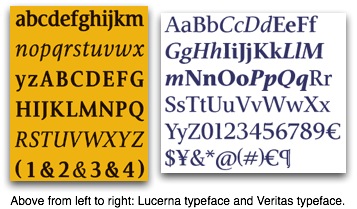
Like any design project, this one had a brief with some technical criteria, to help define and solve the design problem.
• Achieve a better character count (to maximize space and ultimately save paper)
• Eliminate artificial condensing of standard fonts (such as ITC Giovanni).
• Have visual similarities to ITC Giovanni, by Robert Slimbach.
• Make the font "stronger"
• Achieve as good as or better character count than ITC Weidemann or Century Old Style.
• Achieve better character count while maintaining readability.
Tim Botts said afterwards: "I was especially jazzed with the way the new One Year Bible turned out -- a 10% longer text in a stronger typeface -- yielding the same page count! To think we competed with Century OS and Weidemann -- and I think -- won."
We chose some key characters to design with similarities to ITC Giovanni - which Tyndale has been using for many Bibles, condensed 10% for space savings. This was also to show design management that the font would have that warm and friendly look that they had come to appreciate with Giovanni, and that they didn't want to lose. Overall Lucerna has its own character and visual appeal, with limited influence by ITC Giovanni.
So the font is a design solution to these technical and aesthetic considerations. Lucerna has indeed yielded printing/paper savings for Tyndale due to its space-saving design and should prove highly legible for the targeted demographic readers.

While recently visiting the history of the Bible exhibit, Ink & Blood (see my review here), Sooy had a surreal moment. As he toured through the antique Bibles, some of which resulted in martyrs' deaths, Sooy realized that he, too, had managed a contribution to the history of the English Bible:
What struck me the most as I stood looking at the Bibles, reading the stories of the translators, and considering their impact on history – is that nobody was trying to kill me (that I know of) or persecute me (other than the left-wing side of the political spectrum) for contributing to publishing a Bible.
It seemed to me to be a strange culmination of events: I had purchased my first Macintosh (The SE30) in 1990, and released my first typeface intended for Bibles in 1995 (Veritas). Seven years later, I began Lucerna, and the first Bibles typeset in it were released in 2004.
It's difficult to describe the sensation I had while standing in the middle of all this history. The Lucerna Project was significant both personally and professionally, and I am aware that I have been given the opportunity to contribute to the history of the Bible. But why me? I'll always be grateful for the opportunity.
Both the Lucerna and Veritas typefaces are clear and easy to read. These are much better than the narrowed fonts that are in some Bibles, especially thinlines. As I said at the beginning of this post, the Bible is a big book. I hope that publishers will remember that not every Bible coming off the press has to necessarily be a thinline or a compact Bible. There are lots of us out here who don't mind carrying a larger Bible if that means that the text will not be crowded and the pages will not be too thin to write our notes on.
I note that the Veritas font is available for purchase, but Lucerna is not. Veritas was created independently with Bibles in mind, but Lucerna was created under contract for Tyndale. Nevertheless, I wonder how easy it would be to use a font like Veritas (cost = $75) and simply print my own wide-margin Bible. The idea seems more appealing everyday...
For Further Reading:
• "From Genesis to Revelation: Lucerna"
• "From Parchment to Postscript" (Design Matters Blog)
• "Outreach Edition Font" (ESV Blog)
HT: "Picking the Font for the NLTse" (Andrew Dodson's Blog)
Photo of Brian Sooy borrowed from http://www.flickr.com/photos/69297311@N00/sets/654658/
Snakes on a Plane
Want even more fun? There's a nifty page on the movie's website in which you can give a few personal details about your friend or loved one and he or she will receive a personalized message (by email or phone!) from Samuel L. Jackson. How cool is that?
Go to http://snakesonaplane.varitalk.com/
More Thoughts on Wide-Margin Bibles: Here's What I Want

There seems to be a lot of discussion in the blogosphere recently about wide-margin Bibles and Bible note-taking in general.
This will catch you up to speed:
1. A little over a week ago, I wrote a blog entry surveying the current offerings of wide-margin Bibles by various publishers organized by translation. See "A Survey of Wide-Margin BIbles By Version." My goal was to encourage readers to interact with Scripture in a physical way by taking notes in their Bibles. In keeping with my philosophy of "the best Bible is the one that connects to you," I tried to represent as many as translations as possible.
2. In researching that blog entry, I came across J. Mark Bertrand's excellent article on the value of wide-margin BIbles: "Marginal Interest: Why You Need a Wide-Margin Bible." His justification for using wide-margin BIbles was so well-stated, that I merely pointed to his site rather than make my entry any longer than what it already was. See also Bertrand's story about his influence on the ESV Journaling BIble and his post today, "Rolling Justice and Wide Margins."
3. Then, in the comments to my wide-margin survey, Matthew Mansini--a regular This Lamp reader and as it turns out, a connoisseur of wide-margin Bibles--offered an equally worthy description about a number of wide-margin Bible offerings.
4. On a related note, David Lang from Accordance BIble Software chimed in with a question to me regarding my methods of note-taking in Accordance. I embarrassingly admitted that this wasn't one of my habits. I've invited David to write a guest entry for us here describing the process. He's already written two introductory blog entries at the Accordance Blog: "Paper vs. Electronic Note-Taking" and "User Notes: A Personal Example." I will say this, the best justification for electronic note-taking I've heard from David so far came in his comments in the first blog entry where he wrote, "I hate to even mention the possibility of fire to a bibliophile like yourself, but notes in a paper Bible can be just as ephemeral as electronic notes--and they're MUCH harder to back up!" Electronic note-taking may become a habit for me as a way to backup what I've done by hand. Perhaps I will begin to do both at the same time.
5. The ESV Blog has a post today about one Bible Reader's attempt to interleave a blank sheet of paper between each page of his BIble. See "Building Your Own Blank Bible." I seem to remember these kinds of Bibles years ago when I was working in a bookstore. I want to say they were published either by Cambridge or Oxford. Obviously, some folks would prefer this method (although it makes for quite a thick BIble--think TWICE as thick), but my preference is for writing directly on the page, interacting with the text with lines, circles, brackets, highlights, etc.
6. In the upcoming days, look for a blog post here at This Lamp that describes one or two methods/systems for taking notes in a wide-margin BIble.
There are a number of wide-margin offerings out there, but seemingly not near enough. And everyone seems to have a different opinion, but what do YOU want in a wide-margin BIble?
Here's my quick list:
• One column of text. I've never seen a two-column wide-margin Bible where there was ample room for taking notes related to the inner column. The inner column is always cheated because of the binding even when the publisher sees fit to add space on the inside.
• Readable typeface. Minimum of 10 pt.; 11 pt. would be nice. Use normal character spacing as opposed to some of the narrowed text that has been used in Bibles recently to take up less space. Everything about the text should be easy to read.
• Wide margins that are really wide. One and a half to two inches on the outside and one inch at the top, bottom, and inside. If text is one-column, the inside margin is not as big of a deal, but I would at least like a little bit of room for vertical brackets.
• No thinlines! Give us normal paper, not the tissue-like stuff that comes in the average thinline. I want to write in this Bibles without worrying about seeing too much of it on the other side of the page. I don't want the page to curl just because I've written on it and it's too thin. I know that this will be a big BIble, but that's okay. This is not a Bible to stick in a purse! The paper that comes in the Foundation Press single-column NASB or the Zondervan wide-margins are quite adequate in thickness.
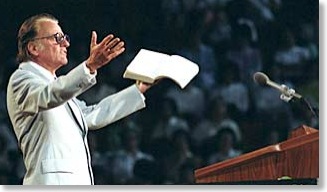
• Quality leather. As this BIble will be intended for use over a long period of time, it should have high quality leather, not just bonded leather like some offerings. Some people prefer hardbacks for writing in, so I suppose a choice in covers would be important.
• Black-letter only. Red-letter Bibles to me are unnecessary as they tend to exalt some words in Scripture above the words of other. It's all God's revelation, so keep it all in the same color. Plus, red text is tiring on the eyes late at night.
• No ruled-lines in the margins. One of the more recently published wide-margin Bibles has tiny ruled lines in the margins for notes. I absolutely don't want these as I like to be creative with my white space. I need the freedom to write vertically if I'm bracketing verses or draw arrows to this and that in the text. Ruled lines would simply restrict my use.
• Regarding the extras. Cross-references outside of those already in the text's normal footnotes are unnecessary. In other words, no columned cross-reference system--this just takes up space that could be used for writing. I may write in my own cross-references or use another source for such. A concordance and maps are nice, but not much else is needed. Perhaps a few blank pages at the beginning, end, and possibly between the testaments would be nice.
These features are what I want in my next wide-margin Bible (I'd really like to see this in a TNIV if Zondervan is listening). Regarding the layout, only Tyndale's Notemaker's Bible and Zondervan's NIV and NASB Wide Margin BIbles have come close to what I describe above (but their bindings leave a little to be desired).
So what do you think? What are your wishes? I know for certain a handful of publishers have dropped by this little blog from time to time. Make your wishes known to them in the comments.
*The graphic of a wide-margin Bible at the beginning of this post was borrowed from the box top for the Zondervan NIV Wide Margin BIble.
Living Life on THE WIRE
And do not be conformed to this world, but be transformed by the renewing of your mind
--Romans 12:2, NASB
It's easier to pull the trigger than play the guitar. Easier to destroy than create.
--El Mariachi (Antonio Banderas) in Desperado
We ain’t never gonna change / We ain’t doin’ nothin’ wrong / We ain’t never gonna change / So shut your mouth and play along.
--"Never Gonna Change" by The Drive-By Truckers, on The Dirty South
The following is something I've wanted to talk about for a while, but had difficulty approaching. I thought about a multi-part series, I thought about a rant, but nothing seemed to work. And then I found out The Wire was starting its fourth season on HBO, and the third season is out now on DVD. And I had my opening.
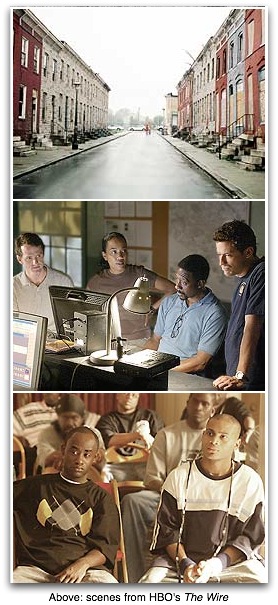
And oh yeah: it's filthy. Maybe not Deadwood or Sopranos filthy (I’ve never had HBO; I've watched all of 15 minutes of Sopranos in a hotel room, so I don’t have a good comparison), but filthy enough that I couldn’t in good conscience watch the rest of the first season, and I haven’t even tried to crack open seasons two and three.
To be sure, and I'm not boasting about this; I’ve seen plenty of movies and television, read plenty of books, and listened to a lot of music with violence, language, sexuality and so on. And our society tends to group things poorly: the movie Almost Famous is a pretty tame R-rated movie compared to Kill Bill; Stephen King will never be mistaken for F. Scott Fitzgerald.
But that’s not my problem. No, my problem is that The Wire is a great artistically satisfying work, yet it also appalls me. And it sums up my issue: can artistic interests and Christianity exist at all?
I sort of touched on this problem in my piece concerning the current state of Christian music. I said more or less that the music industry doesn’t really do a good job of allowing Christian artists to explore musical (and even lyrical) avenues. But I think the problem can be seen all over the place. We have Frank Peretti, but where’s a Christian James Joyce? We have Thomas Kincaid, but where’s a Christian Picasso? We have the Left Behind series, but where’s a Christian Martin Scorcese?
No, those names were not picked randomly. Each one pushed boundaries in some way. They’ve explored life, religion, values, and many other related issues. And I don’t see the current mainstream Christian culture developing in this area. Yes, I know there are many "fringe" and "alternative" Christian artists of all genres, but there are a great many people unaware or unable to locate them, and that is who I’m thinking of. I know there are creative energies in the Christian community, but it could be so much more.
The flipside of the problem is that it seems all the creativity in the secular culture seems to be encased in material designed to be as shocking and/or perverse as possible. Granted, The Wire is a very real, tragic and involving story, but do we need to hear a four-letter word in every sentence? More importantly, is it wise to expose ourselves to this kind of secularism, no matter how much it appeals to us aesthetically? Can I listen to the Drive-By Truckers, a very good Southern rock band that write unbelievably intelligent and beautiful songs, but write about murder, drugs, drink, failed marriages and the like, because I can’t find anything remotely as satisfying in the Christian arena? Is it easier to be fulfilled by what ultimately will destroy you than by what will uplift you? And how does all this affect our relationship with Christ, our testimony, our lives?
I’m sure some people have simple answers--"Just walk away from temptation" and "Fill up on the Word of God" and so on. While those are good answers, I find they are not satisfying ones, because how we handle the world--and how we handle the aesthetic capacity God has given us--is a complex question.
What do you think?
Andrew Wells can be reached at arwell012002@yahoo.com.
Zondervan Updates TNIV.COM
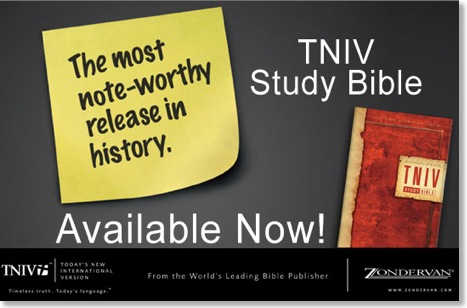
As seen above, Zondervan is calling this "The most note-worthy release in history." Quite a claim, but as I said in my review a few days ago, this is a very significant release for a number of reasons.
At the TNIV.com website, clicking on the graphic displayed above will take you to the main Zondervan description page for the TNIV Study Bible. The product details link at TNIV.com has not been updated yet to reflect the addition of the TNIV Study Bible, but hopefully, this information will be added soon.
Related: My review of Zondervan's TNIV Study Bible
Is the Wikipedia the Hitchhiker's Guide to the Galaxy?
From The Hitchhiker's Guide to the Galaxy (that is, the book by Douglas Adams), ch. 2:
Here's what the Encyclopedia Galactica has to say about alcohol. It says that alcohol is a colorless volatile liquid formed by the fermentation of sugars and also notes its intoxicating effect on certain carbon-based life forms.
The Hitchhiker's Guide to the Galaxy also mentions alcohol. It says that the best drink in existence is the Pan Galactic Gargle Blaster.
It says that the effect of drinking a Pan Galactic Gargle Blaster is like having your brains smashed out by a slice of lemon wrapped round a large gold brick.
The Guide also tells you on which planets the best Pan Galactic Gargle Blasters are mixed, how much you can expect to pay for one and what voluntary organizations exist to help you rehabilitate afterward.
The Guide even tells you how you can mix one yourself.
Take the juice from one bottle of the Ol' Janx Spirit, it says.
Pour into it one measure of water from the seas of Santraginus V--Oh, that Santraginean seawater, it says. Oh, those Santraginean fish!
Allow three cubes of Arcturan Mega-gin to melt into the mixture (it must be properly iced or the benzine is lost).
Allow four liters of Fallian marsh gas to bubble through it, in memory of all those happy bikers who have died of pleasure in the Marshes of Fallia.
Over the back of a silver spoon, float a measure of Qualactin Hypermint extract, redolent of all the beady odors of the dark Qualactin Zones, subtle, sweet and mystic.
Drop in the tooth of an Algolian Suntiger. Watch it disolve, spreading the fires of the Algolian Suns deep into the heart of the drink.
Sprinkle Zamphuor.
Add an olive.
Drink...but...very carefully...
The Hitchhiker's Guide to the Galaxy sells rather better than the Encyclopedia Galactica.
Now hold that thought.
For those of you just tuning in, this post is part of an ongoing conversation between myself and David Ker (host of Lingamish) regarding the benefits and limitations of encyclopedias such as the Wikipedia and Encyclopedia Britannica. David is bonkers over the Wikipedia. I'm much more trusting of the kind of editorial controls found in a more traditional source like Britannica.
Having said that, I use the Wikipedia regularly. I have multiple links to it here on my blog. Encyclopedias are the starting point of research, and as such, both the Wikipedia and Britannica are good sources of information. But in the end, for serious starting points, I simply favor Britannica and its editorial controls.
In David's last post, "The Flattening of Knowledge," he spoke of the benefits of collaboration on the internet. He noted that more people have access to information than at any other time in the history of the world, and more people have an opportunity to be heard than ever before. Both of these ideas are very true, and the Wikipedia embodies them both.
I'm not opposed to access to information by everyone; nor am I opposed to voices being heard. But as I have mentioned before, I have problems with the Wikipedia's absence of--for lack of a better term--quality control. I have already discussed my concern, not with the democratization of knowledge, but the democratization of truth. The advantage of the Wikipedia is also its curse: anyone can contribute. And regardless of whether or not information is true, it can remain in an article unless it's challenged. But even if it's challenged, if the original contributor is persistent enough or if enough other contributors agree (or can be convinced to agree), then the posting becomes fact. This is a problem, no matter how much we revel in all of our voices being heard. And in my opinion, that makes the Wikipedia an unreliable source because information becomes far too fluid.
A second concern of mine has to do with the Wikipedia's lack of editorial discretion. What I mean by this is that there's really no control over what information is included, even insignificant details about a subject or even insignificant subjects themselves.
For instance, the Wikipedia boasts 1,300,000 articles in English. Now the online version of Encyclopedia Britannica only has about 100,000 articles. Does the Wikipedia therefore trump Britannica? I don't think so. On any Wikipedia page, there's a link in the top left side called "Random Article." Here are five clicks I made. I give you my word that these are the articles I received in five successive hits and I haven't fudged the list in any way.
1. British School - Muscat = "a school in Muscat, Oman, catering primarily for the British expatriate community, but containing many students of many different nationalities."
2. Asherah = (from Hebrew אשרה), generally taken as identical with the Ugaritic goddess Athirat (more pedantically but accurately ʼAṯirat), was a major northwest Semitic mother goddess, appearing occasionally also in Akkadian sources as Ashratum/Ashratu and in Hittite as Asherdu(s) or Ashertu(s) or Aserdu(s) or Asertu(s)."
3. Pedro Dimas = "a Mexican violinist, guitarist, composer, and preservationist of traditional music from the Purépecha, an indigenous culture in the Mexican state of Michoacán."
4. Sumed Ibrahem = "(born December 30, 1980 in Tamale, Ghana) is a Ghanaian soccer player, who, as of 2005, plays midfield for the Harrisburg City Islanders of USL Second Division."
5. Abaújvár = "a village in Hungary, next to the Slovakian border. It lies 72 km northeast of Miskolc."
Of these entries, only the second one is also included in the Encyclopedia Britannica. Does this make Britannica inferior? I don't think so. I guess it's good to have all this other information in one handy place, but I think it demonstrates that the sheer number of articles in Wikipedia doesn't mean much as some are so obscure they are essentially irrelevant for the average person. There are articles for everything form comic book characters to individual episodes of television shows. Thus, the Wikipedia is a bit like the Hitchhiker's Guide to the Galaxy as it contains information on just about everything. I suppose that this is not a bad thing, but it does not make it superior to Britannica which by necessity should be more selective in its content.
Another problem with this lack of editorial discretion is the kind of information found in many of the articles. Let me illustrate. Last week, Kathy and I were at home watching the news on one of the cable channels, and after the serious events of the day were exhausted, a report was aired about Paris Hilton having to go to the emergency room in the middle of the night because she was bit by her pet kinkajou. I had never heard of a kinkajou and announced as much to Kathy.
"You've never heard of a kinkajou?" she asked as if surprised.
"No," I replied. "What's a kinkajou."
"Everyone knows what a kinkajou is. It's an exotic pet. Paris Hilton has one."
Not impressed with her explanation, I decided to look kinkajou up for myself in my 2006 edition of Britannica that I have loaded on my PowerBook. I got this short article:
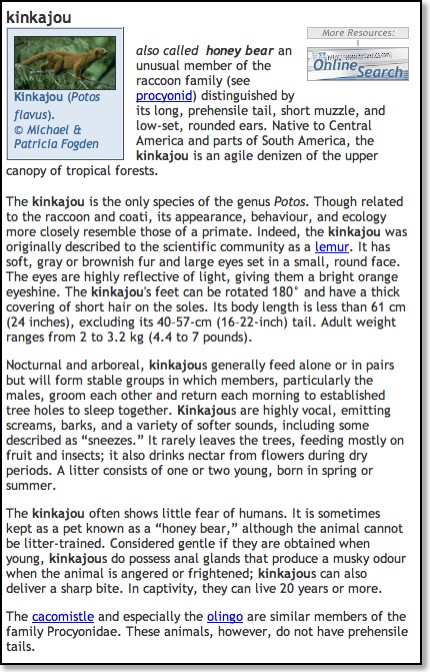
Well, not too bad. It gave me everything I need to know and then some. In preparation for this blog entry, I decided to look up kinkajou in the Wikipedia. To its credit, I got pretty much the same information--at least in regard to the main facts. But I nearly fell out of my chair when I noticed this sentence: "Paris Hilton's Kinkajou, "Baby Luv" has been in the media twice in the past two years; once when he scratched her and the CA Fish and Game Dept issued her a warning for illegally transporting the animal, and again in August 2006 when he bit her arm. Both injuries were minor. Owning a kinkajou in CA is illegal." Is this really important information to put an article about this animal? Will this be relevant in 50 years? In 50 days? [Note: it seems that evidently, there is a Wiki-squabble going on and various forms of the Paris Hilton incident have been added and removed over the last few days. If you decide to look up the kinkajou article and you think I made the whole Paris Hilton insertion up, please look at the history of the article. All I know is that I expect Google hits to my website to triple now that I've used the name "Paris Hilton" five times in one blog entry.] Regardless, this is a prime example of the lack of a final editorial control over the Wikipedia's content. Certainly, someone may remove objectionable content, but there's nothing to keep someone else from putting it back in. Such self-regulation appears very democratic on the surface, but it seems to me that there needs to be a final authority who can simply freeze content.
As an experiment of how easy it is to manipulate an article, I added a reference to myself in one. Now, I didn't add fraudulent information, but I did add irrelevant information. Under the famous residents section of the Wikipedia article on Shreveport, Louisiana, I listed myself as having been born there (which I was). I'm going to paste it here below because I don't think it's ethical for me to leave it there more than about 24 hours just to prove my point.
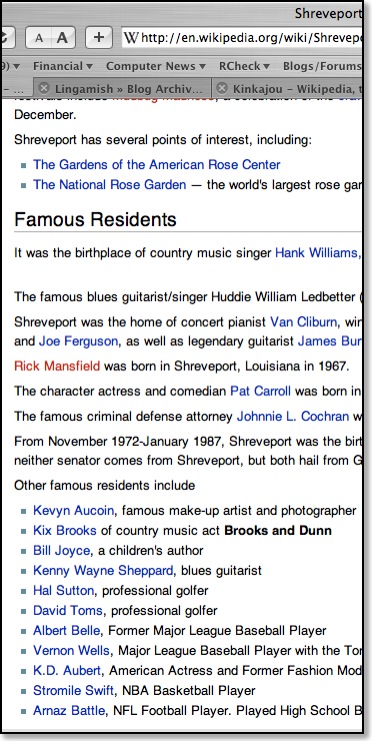
My name is in red because I created a stub for my name so that it could be edited, and thus a new article about yours truly could be created. Don't worry, as I said, I'm going to remove the whole thing. This is just to prove why I believe a peer-edited resource like Britannica is a much more reliable source of information than the Wikipedia.
David, I will concede to you a major point. You wrote in your last post about this subject:
We can talk all we want about how wonderful the editors and writers are for EB but the simple fact is this:
Virtually no one has access to the Encyclopedia Britannica in the 21st century!
So if you consider that to be a problem (I do!), then our primary concern should be creating access to the EB. If the publishers don’t fix that problem, their excellent information is going to become rapidly irrelevant.
Frankly, I can only assume that the rise of the personal computer and especially the internet has hurt Britannica sales dramatically. If video killed the radio star, will the internet kill the bound encyclopedia? Maybe. Britannica is available in three forms: (1) the print bound set, (2) computer editions, and (3) all articles are available via the internet. But unlike the Wikipedia, none of these are free unless you count access to the bound sets at your local library. The fee-based internet editions are primarily sold to schools. The online edition is updated daily, but not by just anyone, and inclusions of pop-culture figures and events are weighed very carefully. But if the PTB at Britannica decided to simply give this information away for free to everyone over the internet, how would they stay in business? This is something I don't have an easy answer for.
Fortunately the Hitchhiker's Guide to the Galaxy says, DON'T PANIC.
Proverbs 22:26
Ummm...What ARE the 10 Commandments?
Appalling on numerous levels.
If you want to see the entire interview, go here.
Official Word from Crossway: No Complete ESV Revision until 2007
Well, the all-seeing eye of Crossway has struck again and this morning they answered the invitation. Stephen Smith, webmaster for Crossway/Good News Publishers and the ESV Bible Blog, sent me an email that not only acknowledged the updated ESV, but also gave a general timetable for the revision's release. In the email, he wrote that we "won’t see any changes to the ESV in print--apart from the reverse interlinear--before 2007."
Here's the official word from Crossway which Smith gave me permission to quote:
We do plan to make a limited number of changes, similar to what most other translations have done a few years after they were first released for publication, though our sense is that the number of changes that we anticipate will be quite a bit less than typically is the case. The vast majority of these involve only minor changes in grammar, punctuation, and footnotes. We are still in process regarding the finalization and implementation of these changes, which we will probably begin to implement sometime next year (2007).
So we will see the updated ESV New Testament via the Reverse Interlinear in the next few days/weeks as it rolls off the printing press and then the entire ESV Bible sometime next year. I would assume that electronic editions will follow thereafter. This is not all that different from the release of any translation since usually the New Testament is seen before the entire Bible. Although the official word seems to downplay the extent of changes in the ESV revision, I know a lot of people hope that it addresses some of the issues pointed out elsewhere.
Stephen Smith also confirmed that the general trends of the ESV in the blogosphere that I reported earlier today are essentially consistent with Crossway's own data, and was kind enough to give me another internet tool with which to play.
Thanks, Stephen, for accepting the invitation to use This Lamp as a venue for an official word on the forthcoming changes in the ESV.
Top Blogged Bibles
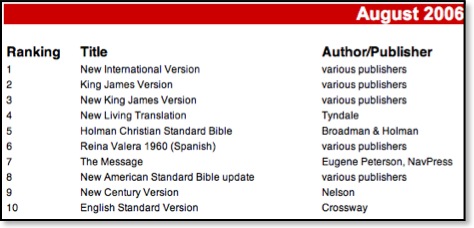
There are problems with these rankings, though. First, these sales probably do not adequately take into account Catholic Bibles sold in many stores that are not CBA members. Secondly, these rankings do not take into account sales of Bibles through non-religious stores in general such as Barnes & Noble, Wal-Mart, or even an online company like Amazon.com. I'm sure that if we could factor in sales from the large chains and a supplier like Amazon, the list might be significantly different. Too bad we can't see a ranking based on shipped items from each of the various Bible publishers instead of what's selling in a select number of stores.
Plus, a bought Bible is not necessarily a read Bible. To me, what's more interesting than the list of Bibles sold above might be a near-impossible-to-find list of Bibles that are used. As I was thinking about this, I wondered if we could get a listing of Bibles mentioned on the internet, specifically in blogs. So I did some searches for version abbreviations on Technorati and the results are very interesting.
A few notes before I show you the list. First, there was no reasonable way to determine the use of Eugene Peterson's the Message on the Internet because there's no standard abbreviation and the simple phrase "the message" might refer to many things beyond the Bible paraphrase. Similarly, there's no real way to search for the New American Bible because "nab" is also a word. Second, for similar reasons, I'm not including an searches for anything other than English translations. And third, a blog such as this one refers to many different translations, so none of these figures represent exclusive use of a translation. But even if I use the ESV for comparison's sake as opposed to a primary Bible, I'm still using that translation and such use bears some significance. Fourth, this survey does not include Bible references made in which no translation reference is made at all, and I assume there are a large number of these. Fifth, all of these numbers are inflated to some degree because these same abbreviations that I'm searching for are used in some blogs for other things. This issue was so significant, for instance, when I searched for "JPS" and "REB" that I chose not to include the results at all. In other words, these are not not scientific or exact measurements, but they are interesting measurements.
In the list below, I am listing translations in ranked order from highest to lowest. I am also including the "Mentions by Day" chart from Technorati for sake of comparison.
1. NIV: 74,723 hits

2. KJV: 29, 466 hits
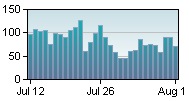
3. ESV: 19,174 hits
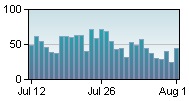
4. NLT: 19,122 hits

5. RSV: 13,351 hits

6. NASB: 11,422 hits + 823 hits for the incorrectly designated "NASV" + 146 hits for NASB95= 12,391
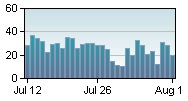
7. NKJV: 11,906 hits

8. NRSV: 5,877 hits
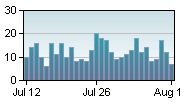
9. TNIV: 2,855 hits
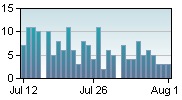
10. NCV: 2764 hits

11. HCSB: 1,206 hits + 81 hits for "Holman CSB" = 1,287 hits
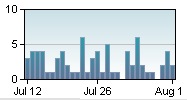
12. NJB: 827 hits

A number of observations:
• The top two spots belonging to the NIV and KJV aren't surprising, but what is surprising is how the NIV dwarfs all the other translations by comparison. It has almost two and a half more hits than the closest runner-up, the KJV; and it accounts for 40% of all hits combined. The number is so high that I went back after compiling all the numbers and ran the search for "niv" again so that I could take a closer look at the results. I wondered if "niv" wasn't a common abbreviation for something else. But a cursory glance revealed that most of the references were to the Bible and that the numbers for the NIV didn't seem any more inflated than the other numbers.
• Note that the ESV is #3 for blog usage compared with #10 for CBA sales. It even beats out the NLT, though not by much.
• Note the significant number of hits for the RSV and NRSV even though neither show up on CBA sales charts at all. The RSV may be a bit more inflated because evidently there's also a RSV virus to which some of the entries were in reference.
• Although the HCSB is ranked #5 on the CBA chart, it's near the very very bottom of the Technorati search. Maybe lots of people are buying HCSB Bibles, but they sure aren't blogging about it. Even the TNIV has more than twice as many hits as the HCSB.
These are just some initial thoughts. What do you notice in looking at the numbers? Leave your thoughts in the comments.
A Survey of Wide-Margin Bibles By Version
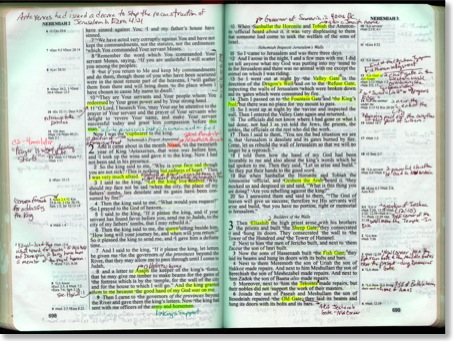
Above: a two-page spread from my NASB Side Column Reference Bible from Foundation Press. Pardon the messy handwriting.
I've always made the suggestion to my students to read the Bible daily, and study the Bible one to two times a week. To me there's a difference between the two. Perhaps in a future blog entry, I'll give greater delineation, but for right now let me suggest that real study of the Bible will include taking notes, and for me, I enjoy writing the most significant information directly into my Bible. I find my own habits humorous, but difficult to break. Perhaps it goes back to that overly exalted view of the physical Bible, but I find myself writing in my Greek New Testament only with a pencil. Usually these marks are of a textual or grammatical nature. Or sometimes I write in an English gloss for a very obscure Greek word. However, in my wide-margin NASB, I write in a multitude of ink colors and dry highlighters (I'll have to soon blog separately about my marking system, too). The notes in my English translation range from background information, underlying Greek or Hebrew wording, commentary, my own thoughts and reflections and profound quotations picked up here or there that seem to go with the text. Perhaps I'm more conservative to the Greek text because it's nearer in my mind to those actual autographs. I don't know, but my system is working for me.
My current habit is to study a passage of Scripture making the appropriate notes in my Greek New Testament and a wide-margin NASB from Foundation Publications. I prefer a more formal, literal translation for my notes, but I'm not saying that you have to do the same. I have a second wide-margin that I'm also using these days. Since our Sunday School literature uses the Holman Christian Standard Bible (and because I really like this translation), I have a copy of the HCSB Minister's Bible that I take with me on Sunday mornings to church. Since it's margins are smaller, and because I don't need everything I've noted anyway, I copy a subset of notes into my HCSB. Again, this is a system that is working for me.
I know that for some, it's very hard to start writing in the margins of your Bible if you grew up with the same mindset that I did. But I can testify to you, that I've never once accidentally mistaken one of my notes, written in the margin, as actual Scripture. And if you saw my handwriting, you'd agree that there's no chance of making that kind of mistake. I encourage everyone to make a habit of taking notes in your BIble. You will be amazed at how your Bible study is enhanced and how much those notes will come in handy at a near or later date. For even more encouragement on this subject, I would direct you to a blog entry by J. Mark Bertrand, entitled "Marginal Interest: Why You Need a Wide-Margin Bible."
In light of my encouragement to you to use a wide-margin Bible for personal study (in the translation of your choice), I have made a search on the internet for available wide-margin editions and grouped them according to translation (listed alphabetically). Below, I've tried to comment on these Bibles giving you the positive and negatives. I am not going to comment on extra features in a particular Bible such as the minister's helps in the HCSB Minister's Bible as that is not relevant to this blog entry topic. I have examined most of these Bibles by hand and I personally own two of them. Rather than linking to a particular outlet like Amazon.com, I am instead giving you the ISBN for each particular publication. All you need to do to find a supplier is to search for an individual ISBN in Google or your preferred search engine. You can also take these ISBNs and search for them directly on a site like Amazon.com or Christianbook.com or even give the number to a local merchant for ordering.
English Standard Version (ESV)
I'll hand it to Crossway for coming up with a number of really nice bindings that combine a traditional look and feel with quality materials. There are essentially two ESV Bibles with wide-margins.
Deluxe Reference Edition
These Bibles feature a traditional two-column text with a center column reference. Margins for taking notes are slightly less than one inch. The premium calfskin edition is one of the nicest (but also most expensive) ESV Bibles money can buy. Nitpicks: Top and bottom margins are not wide and therefore not suitable for much note-taking. Also the inner margins will not give you as much room for notes simply because of the binding itself.
Hardcover: 1581344368
Bonded Leather: 1581344384
Premium Calfskin: 1581343507
Journaling Bible
This edition of the ESV Bible is a fairly new release from Crossway and has received lots of attention. I really like the concept of this Bible, but I have a number of problems with the final product. Regardless, there's a lot to like here. The ESV Journaling Bible looks like something out of the Moleskine Catalog. It's hand-sized as a change of pace from many wide margin Bible and has a generous two inches of note space at the edges of the page. It has a two-column layout with center-column cross references. The paper is off-white, giving it an antique look in keeping with its moleskine design. The outer cover of the less-expensive edition (I haven't handled the calfskin leather one) is a padded hardback with an elastic strap (again in moleskine fashion) to keep it closed when not in use. I initially read in one review on the internet that it opens flat, even at Genesis 1, and while in a bookstore recently I confirmed that to be true. The price is also right for this Bible. I've seen it as low as $17.99 at a couple of websites. Nitpicks: I haven't heard anyone say a positive word about the size of the print. It's a tiny 7.5 type, the size in your average compact Bible. This is way too small to be useful as a note-taking Bible in my opinion, in spite of my attraction to the compact size. I think you just can't easily have both. Also, while I generally prefer a one-column text layout over two columns, if there are two columns in a Bible designed to take notes, it's imperative to have space next to the inner column. Otherwise, it's hard to designate notes for the inner column. And this is just me, but I would prefer no ruled lines since I often bracket verses and even write vertical headings. Perhaps Crossway is making a distinction between a Bible to journal one's thoughts in as opposed to a Bible to write notes in. I don't know. Regardless, as I said, I really like the concept of this Bible, but until another edition comes out that addresses some of the above concerns, I would have to recommend the Deluxe Reference Edition as a note-taking Bible to the person partial to the ESV.
Original (Elastic Strap): 158134838X
Calfskin Leather: 1581348398
Holman Christian Standard Bible
To my knowledge, there is currently only one wide-margin HCSB Bible available as of this writing, but I would hope that there will be more coming as this translation is still fairly new.
Holman CSB Minister's Bible
The HCSB Minister's Bible has a nice single-column text that is at a decent 9.5 pt. typeface in a text layout that feels neither crowded or rushed. The one-inch margins are at the outer edge, top and bottom of the page, but not in the center of the spread. The text has only black typeface (which I prefer), and the quality of the leather is good with raised ribs on the spine adding a nice touch. This is the Bible I teach out of on Sunday mornings. Nitpicks: The paper in this Bible is too thin. In an attempt to create a Bible suitable for taking into the pulpit, B&H made this Bible a quasi-thinline by using thinner paper. When you write on a page, the paper will curl. Closing the Bible for a while corrects this curling, but it can be annoying while you are using it. Personally I believe the sweet spot for a wide margin Bible is one and a half inches, not one inch alone. In poetic and prophetic sections, there is ample room for notes. But in prose sections such as the gospels or the epistles, there really isn't adequate room to write extensive notes. I can't imagine a pastor trying to copy his outline in these margins. Also, for the person who does not consider himself (or herself, as the case may be) a minister, the title on the spine may be a bit disconcerting.
Black Leather: 1586401696
New American Standard Bible
There have been a variety of NASB wide-margin Bibles along the years in both the original 1977 edition and the updated 1995 edition. Currently, I cannot find a single-column NASB text that is also in paragraph format.
NASB Side-Column Reference Wide Margin (Foundation Publications)
I use this Bible myself. The paper is thicker than that in many of the Bibles on the market today which is helpful for reducing bleedthrough. The outer edges sport a one-inch margin but the nature of the side-colmn references often allow for another inch of space (see the scan of my copy above) for passages with fewer cross-references. Regardless of the debate about verse-by-verse format vs. paragraphs, the nature of the individual treatment of the verses allows the user to add notes above and below verses in some cases.This Bible will lay flat immediately, and the bindings of all Foundation Press Bibles is usually well above par. Nitpicks: There seems to be less room in the 1995 update than in the previous 1977 edition. There used to be more space between chapters and at the beginning of books of the Bible. This newer edition feels a bit cramped at times. If you prefer passages in paragraph format, you will be disappointed in all of the wide-margin NASB Bibles, not just this one. I could also do without the vertical line between the cross-references and the text.
Blue Hardcover: 0910618461
Burgundy Bonded Leather: 091061847X
Black Bonded Leather: 0910618488
Burgundy Genuine Leather: 0910618496
Black Genuine Leather: 1885217668
Blue Genuine Leather: 188521796X
Blue Genuine Leather Thumb-Indexed: 1581350384
Burgundy Genuine Leather Thumb-Indexed: 188521782X
Black Calfskin: 1581351127
Burgundy Calfskin: 1581351135
Blue Calfskin: 1581351143
Zondervan NASB Wide Margin Bible
There's very little not to like in this Bible. The most impressive feature is the two-inch outer edge margin. There is lots of extra space at the beginning of books and an incredible amount of space for writing in poetic sections. The pages are thick enough not to easily bleed through. Nitpicks: Very minor really. Personally, I like the cross references in the Foundation Press NASB Bibles, but if this is not an issue to you, the greater space for notes is to your advantage. the type-size is at an 8.8 slightly smaller than some wide-margin Bibles. I recommend viewing the print in a store before buying this Bible and subjecting weak eyes to hours of staring at the text. I might also wonder how these bindings hold up after a few years' worth of use. There is nothing above a bonded leather grade available.
Hardcover: 0310921848
Burgundy Bonded Leather: 0310921856
Black Bonded Leather: 0310921864
The New Inductive Study Bible
Fans of Kay Arthur's Precept Bible study methods will appreciate this wide margin edition of the NASB. However, I have also personally known individuals who bought it simply for its large typeface and one inch margins. This is a large Bible with thicker paper than some Bibles, specifically designed to be written in. Nitpicks: Often the margins will be filled with study helps completely obscuring the area for writing in your own notes. Unless you're a Precept student, I would recommend buying one of the other Bibles listed here.
Hardcover: 0736900160
Hardcover Thumb-Indexed: 0736900225
Burgundy Bonded Leather: 0736900179
Burgundy Bonded Leather Thumb-Indexed: 0736900233
Burgundy Genuine Leather: 0736900187
Burgundy Genuine Leather Thumb-Indexed 0736900241
In Touch Ministries Wide Margin Edition
The margins go around the entire two columns of text with these dimensions: 1.25 inch outter margin, bottom, 1.30 top, 0.75 inch inner margin. The differences between this bible and the side-column wide margin is that there are no references or translation notes in the margin space leaving more space to write. The In Touch edition is not branded by Charles Stanley, but merely has an Introductory note from him, right after your presentation page. He isn't even on the copyright page, which informs you that this is a Note Taker's edition of the NASB. This edition has a 10.5 pt. typeface. Nitpicks: The inside margin is too narrow to be usable.
Hardcover: 1581350732
Burgundy Genuine Leather: 1581350686
Burgundy Calfskin: 1581350708
Black Calfskin: 1581350716
Blue Calfskin: 1581350724
New International Version
I know of three wide-margin editions of the NIV. If you know of others, please let me know.
Cambridge NIV Wide Margin
If you prefer your text in two columns, Cambridge wide-margin editions are better than anything else you'll find. They really get this right. Many of these editions are more expensive than what you'd pay for other bindings, but you get what you pay for because the quality is matched by just about no one else. One reason why Cambridge gets these editions right is because the margins (over an inch) go all the way around the two columns of text, including the inside of the page. Nitpicks: None of any real significance. The only detractor is the cost, but note that an edition is available in imitation leather at a very affordable price.
Black Imitation Leather: 052160334X
Burgundy Bonded Leather: 052150869X
Black Calfskin Leather: 0521508797
Black Goatskin Leather: 0521691206
NIV New Inductive Study Bible
See description of NASB edition above. The only difference in the NIV edition is paragraph format for verses.
Hardcover Thumb-Indexed: 0736900225
Bonded Leather Thumb-Indexed: 0736900233
Genuine Leather Thumb-Indexed: 0736900241
Zondervan NIV Wide Margin Bible
Single-column text--for a complete description see the Zondervan NASB Wide Margin Bible above. The only difference in the editions is the paragraph format of the NIV Wide Margin.
Hardcover: 0310922143
Black Bonded Leather: 0310922151
Navy Bonded Leather: 031092216X
Burgundy Bonded Leather: 0310922178
New King James Version
There's only one NKJV Bible to my knowledge, and it may be out of print.
Holy Bible Wide Margin Center-Column Reference Edition
I have not actually seen one of these Bibles firsthand. The Thomas Nelson website seems to indicate they are in print, but Amazon does not offer anything but used purchases. Regardless, they are the only wide-margin NKJV's I can find. The TN site describes them as "Printed on heavy paper to lessen 'show-through' from ink or pencil inscriptions, each page has a wide margin completely surrounding the text. Center-column references and translation notes open doors to in-depth Bible study." Obviously, these are two-column Bibles, and from what I read at Amazon.com, the margins are one-inch and includes the inside of the page. Nitpicks: Reading the comments at Amazon, I gathered that the paper might not be as thick as what the TN description describes. However, I would never recommend using any pen but a ballpoint anyway to avoid bleedthrough. There was also a comment suggesting the the top margin was more narrow than the other margins.
Hardcover: 0840728905
Burgundy Genuine Leather: 0840728948
Black Genuine Leather: 0840728921
New Living Translation
There are currently no NLT wide-margin Bibles in print, and I have confirmed this with Tyndale. However, an out-of-print edition that I mentioned in a blog entry the other day can still be obtained at very reduced prices, so I am going to list these here for reference. Note that these are only available in the first edition NLT (1996), not the second edition (2004).
NLT Notemaker's Bible
I have to say up front that the layout in the NLT Notemaker's Bible may be the best layout of any wide-margin Bible in my opinion. This Bible has a generous 1 1/2" margin on the sides for notes and an incredible two inches of lined space at the bottom for journaling. The text is in a single-column format (which I prefer for a wide-margin Bible) and I don't know the exact type-size, but it's definitely larger than your average reference Bible and easy on the eyes. The pages are also thick enough that reasonable note-taking shouldn't bleed through. Words of Christ are in black (which I prefer). If you prefer leather over hardback, Tyndale has really improved the quality of their leather--even bonded leather--in recent years, and the Notemaker's Bible is no exception. This is a quality-made Bible that will last a long time. Nitpicks: These are obvious--this edition is out of print and only available in NLT1. I wish other publishers would take note (pun intended) and apply a similar layout to other translations. Some might object to the ruled lines at the bottom, but the space between the lines is more generous than that in the ESV Journaling Bible, so that might not be a problem. Be sure to check Christian Book Distributors for extremely low prices while supplies last.
Hardcover: 0842375724
Black Bonded Leather: 0842375732
Burgundy Bonded Leather: 0842375740
New Revised Standard Version
To my knowledge, there are no wide-margin NRSV Bibles currently in print. For a while, Cambridge published a wide-margin NRSV, and I am offering those ISBN's below as they can still be obtained used.
Cambridge NRSV Wide Margin Bible
Presumably, these Bibles would have a similar layout to the Cambridge NIV Wide Margin that I described above. Please see that description above for more details.
Hardcover: 0521507790
Burgundy Bonded Leather: 0521508436
Today's New International Version
The TNIV is the newest translation in this survey, and there aren't too many choices yet. I would like to see Zondervan publish an edition of the TNIV similar to their wide-margin NIV and NASB offerings. I assume that such editions will be available in the future.
TNIV Thinline, Square (TNIV Thinline Bible2)
These Bibles are just what they say they are--they're square. Zondervan has taken a TNIV Thinline Bible and added about an inch and a half to the outer margins for the purposes of note-taking or journaling. Nitpicks: I have the same criticism of this Bible that I have for many two-column wide-margins--there's no room for taking notes on the inside of the page to relate to the inside column of text! There's also a thin vertical line between the text and the outer margin that might get in the way if you take notes like I do with lots of lines and arrows. The paper is really too thin to use this Bible longterm for notes (in my opinion, thinline Bibles don't make good note-taking Bibles). Personally, I'm not wild about any of the covers of these Bibles, but I suppose that's off-topic.
Italian Duo-Tone, Dark Burgundy/Pale Blue/Brown: 0310934990
Italian Duo-Tone, Dark Burgundy/Tan: 0310935008
Italian Duo-Tone, Bright Pink/Melon Green: 0310935016
Italian Duo-Tone, Meadow Green/Melon Green: 0310935024
Questions? Thoughts? Comments? Rebuttals?
Some of this information is incomplete. If you have a correction or know information I don’t, please let me know and I will add it to this entry. Here are some questions that I could foresee some folks having:
What about original language texts?
I do not know of any Greek or Hebrew texts with wide margins. There used to be a 26th Edition Nestle-Aland Greek New Testament with a wide-margin, but I do not know the ISBN. Personally, for taking notes in a Greek New Testament or Hebrew Bible, I recommend that you use the larger print editions (which I use myself):
Large Print NA 27: ISBN 3438051036
Large Print (technically the standard edition) BHS: ISBN 3438052180
What about the KJV or the Message?
I don’t know of any wide-margin editions of the Message, but I didn’t look. Also, Cambridge has a nice selection of wide-margin KJV Bibles in a similar layout to the Cambridge NIV Wide Margin Bible I described above. I did not include either of these translations in my survey because I personally don’t recommend either for serious study, although they have other value.
What about the CEV? GNT? NCV? GWT? NAB? NJB? RSV? REB? Or my other favorite translations?
As far as I know, there aren’t any wide-margin editions available for these translations. If you know of one, please send me a description and I’ll amend this blog entry.
Redacted 10:30 PM. Special thanks to Matthew Mansini for his information regarding the NASB In-Touch Ministries Edition. be sure to read his additional insights regarding wide-margin Bibles in the comments.
Truth Unchanged Changed? Revised ESV Release Imminent: Solid Evidence
Then yesterday, in a post on the Bible Translation Discussion List, David Dewey, author of A User's Guide to Bible Translations, wrote these words:
There has been increasing speculation about when a revised ESV might appear. The answer looks like being next month. There is a clue - even hard evidence - on the ESB blog site. A few entries ago (on August 2) they posted details of the forthcoming reverse interlinear. This includes a reproduction of the start of Acts 1. Close observation reveals that verse 3 has been revised. The existing ESV (including even the new journalling edition) has, 'To them he presented himself alive...' The interlinear has the rather more natural, 'He presented himself alive to them.' Does this suggest that most of the revisions will be to awkward word order? And if one revision is found in just four verses, how many changes might there be in total?
Am I not suprised that Crossway have included their revisions in the interlinear. To have kept the unrevised text would have been foolish: typesetting an interlinear is enormously expensive and it is not something you are going to want to drop for a second edition in a hurry.
You've got to hand it to Dewey. I had seen the post on the ESV Blog myself, but I certainly didn't take the time to compare the text in the photo to the actual ESV text currently available.
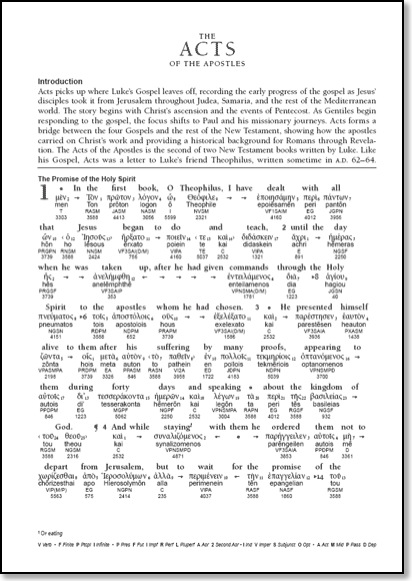
But he's certainly right. The rather awkward phrasing of Acts 1:3 in the current ESV, "To them he presented himself alive after his suffering by many proofs, appearing to them during forty days and speaking about the kingdom of God" has been changed in the ESV Reverse Interlinear to "He presented himself alive to them after his suffering by many proofs, appearing to them during forty days and speaking about the kingdom of God" [emphasis added to designated revised wording].
One has to wonder if the writer of the ESV Blog displayed this particular page from the first chapter of Acts on purpose as a hint of the forthcoming release or if it was something that just slipped through? Regardless, the text has been changed in v. 3, and I would agree with Dewey's speculation that a revised ESV text may be released very soon, or at least released initially by way of the ESV Reverse Interlinear since this volume is now being printed. It will be interesting to see if the revision won't merely be introduced quietly--with no fanfare--so as not to cannibalize sales of current editions.
Nevertheless, the question regarding how extensive the revision will be is of most interest to me and undoubtedly many others. I will admit that although I regularly use the ESV as a parallel text for comparison's sake, I've never really warmed to it as a Bible translation. I have nothing personal against the ESV, but I've never been quite as excited about it as a number of my peers (I have much greater preference for the HCSB as a recent formal equivalent translation, and I teach from the HCSB at church). I've described the ESV elsewhere as often feeling rushed--that is, certain archaic renderings left over from the RSV (and some even from the KJV) that I feel should have been updated in a 21st Century English translation were simply left as is. I realize that the backers of the ESV were going for a more traditional translation, but it just often seems to be awkwardly traditional in places. For some specific examples, see the "ESV Translation Problems" section on Wayne Leman's ESV Links Page.
Special thanks to Wayne Leman, moderator of the Bible Translation Discussion list and contributor to Better Bibles Blog, for sending me Dewey's post last night hours before I received it this morning in the list digest.
The Sum of Human Knowledge*
Well, he didn't quite put it in those terms, but that's the feeling I got from him in our friendly little debate
Be sure to read David's entire blog entry, but here are a few main points:
The bigger picture here is globalization and democratization of knowledge. Wiki knowledge fits within the framework of a new way of organizing knowledge in the modern world. The era of printed collections of information gathered by an elite group of experts is slowly coming to an end.
I see googlization as a positive trend but it brings with it a big change in how we access information. I remember writing a paper on the subject of royalty in the history plays of Shakespeare. In order to find the quotes I needed I had to actually... gasp... read the plays! Over and over again. Can you imagine! What would you do today if you were writing such a paper? You'd google the topic of course! You'd start googling combinations of keywords until you were pointed to an online information source that perhaps allowed you to search Shakespeare's plays. In the process you'd probably come across other writers who had tackled the subject and use them in your bibliography.
So, Rick, I respect your concerns. We're all concerned about Wikipedia being abused for political and ideological reasons. But frankly, Encyclopedia Britannica has its own political and ideological aims as well. The difference is that with Wikipedia you have a collective mind composed of hundreds of editors "mediating truth" rather than some ivory tower cabal working at EB. Rather than shooting down Wikipedia, I think the real discussion we need to have is how can trusted sources of information like Encyclopedia Britannica embrace Wiki forms of information gathering and disseminating in order to stay dynamic.
Wikipedia is a new kind of encyclopedia for a new kind of mind. The global citizen is going to need global information and it is unlikely that this knowledge is going to carry the name of an 18th century colonializer.
That last line was quite a cheap shot, don't you think?
Anyway, taking the high road, I ignored the ad-biblionem attack, and gently responded with these words in the comments:
No, I don't want Britannica updated by Wikipedia's methods.
Here's the deal...I'm not completely against the Wikipedia. I use it regularly and have quite a few links to it on my blog. I created a link to it in the blog I wrote today.
But I have trouble being confident in the Wikipedia for any kind of serious investigation of a subject. I might go there, but I don't know who wrote the information and I don't know how accurate the information is. At least with Britannica, I can at least know it was written by an expert in the area. Granted, "experts" can have bias, too, but at least the information in Britannica is not a moving target.
As for research as in regard to my students, the real problem is that the average student--high school, college, and even higher--does not adequately know how to discern good sources from bad sources.
I've watched as students run searches in Google and immediately run to the top selections regardless of whether they are actual good sources or not.
I'm not afraid of the democratization of knowledge, but more of the democratization of truth. That's what Colbert was driving at. If enough people think it's true, it becomes fact. And unfortunately, too many people don't know the difference.
Then in a counter-point to my counterpoint to his blog entry which was a counter-point to my blog entry, David wrote the following:
1. Determining truth. You see the concept of an "expert" being a safe-guard against falsehood, while I see the concept of "democratic editing" being that safe-guard. Maybe another way of looking at this is that it is an authority question.
2. Old vs. new media. Wikipedia and EB represent two very different forms of publishing. It seems to me that the rate of information growth and change in this century makes the thought of waiting 20 years to get an update unthinkable. At the same time, hyper-editing at Wikipedia seems fraught with danger.
My response: Point #1. It's not merely the "concept of an 'expert' being a safe-guard against falsehood," but rather an expert who is peer-reviewed by other experts (i. e., Britannica's editorial board). Granted, any such individual or group can have agendas or political biases, but at least I know my source since the larger and more significant articles in Britannica are signed. Yes, it certainly is an authority question, because if I read something on the Wikipedia, I have to ask, "Says who?"
Point #2. Britannica editions are actually becoming updated more quickly. For the print edition, a new 16th edition was recently released, plus they release updates annually in their Book of the Year 20XX. And as for the online edition, they update the content daily (okay, I'll admit that I learned this last fact from the "Encyclopedia Britannica" entry on the Wikipedia. So?).
And, David, your last sentence: "...hyperediting at Wikipedia seems fraught with danger." That's entirely my point--couldn't have said it better myself. The problem with the Wikipedia as a consistently serious source of factual information is that the content is--or can be--a moving target.
So, finally, in the spirit of solidarity for Britannica fans and Wiki-skeptics everywhere, I have created a brand new Britannica-linked web badge that will permanently stay in my sidebar. The Britannica button shows my support for the time-honored encyclopedia set (but doesn't necessarily mean I'll start to link to articles on the online edition since you have to pay for that, and I doubt that many of you have a subscription).
And David, just remember that every time someone reads your anti-Britannica blog and decides to forego a purchase of the print set in favor of a relativistic, knowledge-and-truth-democratized online source, well... that's 32 extra days in purgatory for you after you die (one day per each volume in the current set).
*The phrase "Sum of Human Knowledge" comes from a 1913 advertisement for the 11th edition of the Encyclopedia Britannica.
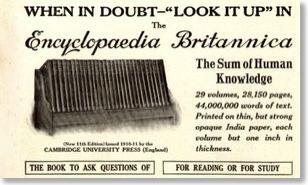
Image Source: Wikipedia
Ecclesiastes 7:9
Review: The Zondervan TNIV Study Bible
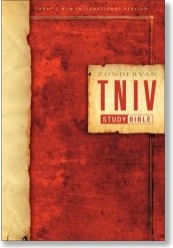
In comparing my 1985 NIV Study Bible to the new TNIV Study Bible, I notice that there have been a number of improvements to the layout. Dark red squares around chapter numbers allow readers to quickly fix their eyes at the beginning of the chapters. The boxes around page numbers and reference headings at the top of the page allow the reader to find the right page much much quicker. There are A's, B's, and C's in the study notes allowing the reader to quickly identify (A) Application Notes, (B) Background Notes, and (C) Character Information.
The font for the biblical text is slightly smaller than my copy of the first edition of the NIV Study Bible, but the difference is negligible. The font for the notes is sans-serifed unlike those in the NIV Study BIble, so that makes for darker print and easier reading.The pages are thin, but I have Bibles with much thinner pages, so this really seems to be a non-issue. Unfortunately the words of Christ are in red, something I really prefer a Bible not to have but at least it's not the bright red found in Bibles a generation or two ago, so I can live with it. However, I am greatly pleased that the editors decided to go with a single-column format instead of the two columns in the original edition.
If anything, what's most important is the content in the TNIV Study Bible. In comparing this Bible with my first edition, I notice about 300 pages of more content in the new Bible, which really would have been even greater if font size had not been reduced in the biblical text. The specs on the Amazon.com page report 2496 pages and that sounds about right. All of the notes (over 20,000), introductions (66), charts and timelines (39), maps (49 black & white in-text and 16 pages of satellite generated full-color maps) and tables have been updated to the TNIV, one of the most accurate contemporary translations available.
There are also seven essays scattered throughout the text on the following subjects:
1. The Conquest and the Ethical Question of War
2. Wisdom Literature
3. The Book of the 12 and the Minor Prophets
4. The Time Between the Testaments
5. The Synoptic Gospels
6. The Pastoral Letters
7. The General Letters
The reader will also find features such as an extremely detailed TNIV Harmony of the Gospels and a section on major archaeological studies relating to the New Testament. The person interested in Ancient Near Eastern literature will appreciate the annotated list of Ancient Texts Relating to the Old Testament.
Plus there are an incredible FIVE ways to find content: (1) an extensive TNIV concordance, (2) A biblical subject index (because sometimes you know the subject but not how its worded in the verse), (3) an index to the study notes, (4) an index to the black & white in-text maps and (5) an an index to the color maps. I don't think I've ever seen a Bible that approached finding information in so many ways.
The Zondervan TNIV Study Bible was just released this week. Since there was not a discount yet at Amazon, I tried to be a good Christian patron, but three of our local religious bookstores did not have it in stock (and of course, one particular chain I didn't even try because I knew they wouldn't have it). Fortunately I was able to procure it at one of our local Borders Bookstores. Of course, I imagine it will be in most regular outlets over the next few days and weeks.
I emailed Zondervan a few days ago asking why they weren't promoting it front and center at TNIV.com (there's no mention of it as of this writing). They sent me back a very friendly reply stating that they were waiting until all editions (leather, personal size, etc.) were released over the next few weeks and then they have a pretty big campaign planed for it as they see its release as a very big deal. Since there seems to have been very little promotion for the TNIV over the last few months, I'm very glad to hear this.
I bought a hardback copy (all that is available this week) because I plan to mainly use the TNIV Study Bible at home as a reference tool. Yes, this is a big Bible (almost 2500 pages and 3.82 lbs. according to Amazon), but it packs an entire library of information in about 2" of thickness. But if you plan to carry it to church or Bible study you might want to wait for one of the personal-size editions. This assumes, of course that your eyes are better than mine! Regardless of which size you prefer, I would unconditionally recommend this Bible for any believer at any stage of spiritual development. Take it with you to church or buy it as an extra reference Bible for your study. Either way, you can't go wrong.
The launch of the NIV Study Bible in 1985 was significant because up until then, most study Bibles had revolved around one person's or one theological system's interpretation. The NIV Study Bible was a huge contribution because it delivered biblical background, exegesis and commentary from dozens of the finest scholars in the evangelical world. As I look around at the scope of study Bibles today, I still see a lot more of the same, but perhaps even more specialized toward someone's perspective or a particular theological system. That's not to say that those perspectives don't have valuable points of view to offer, but in a study Bible I prefer the checks and balances of a more diverse approach. The title across the font of the TNIV Study Bible's dust jacket reads "Today's most comprehensive study Bible." Like it's predecessor, the TNIV Study Bible stands on solid ground as being exactly that and a fine inheritor to a great tradition.
Of Related Interest:
- My Review of the TNIV Translation
- Follow-Up to My Review of the TNIV
The New Jerusalem Bible (Top Ten Bible Versions #7)
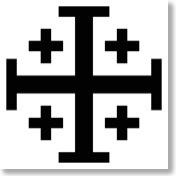
Essentially, there are three primary Catholic translations in use in North America today (although there are a few more minor ones and a number of Protestant Bibles which also have editions available with the deuterocanonical books such as the NRSV, REB and NLT). The most widely used Catholic translation in North America is the New American Bible (not to be confused with the Protestant New American Standard Bible). The older and more traditional Douay-Rheims Bible (based on the Latin Vulgate) is often preferred among more conservative Catholics. And the New Jerusalem Bible (NJB), while not used as much on this continent, is supposedly the most popular translation in other English speaking countries.
History. The NJB is an update to the older Jerusalem Bible, which incidentally included J. R. R. Tolkein of Lord of the Rings fame who contributed as an English stylist primarily working with the Book of Jonah. However, the NJB, like the Jerusalem Bible before it, is essentially an English adaptation to the French Bible de Jérusalem. According to David Dewey (see comments below), "the NJB differs from the JB in that the latter is a translation from the French with reference to the original languages, whereas the former is a translation from the original languages with reference to the French." The NJB update was released in 1985, and since the French version is now in its third revision, some have speculated that the NJB may receive a forthcoming update as well.
My experience with the NJB began in the late 1980's shortly after its publication when I decided to read through a Bible that included the deutercanonical books. I wanted to do this with a Catholic Bible so that these extra "apocryphal" books would be found in their traditional place in the text as opposed to a separate section where most Protestant Bibles place them. In comparing the NJB to the NAB, I found the former to be a bit more of a smoother read, and I still agree with that summation today. I am not as familiar with these translations as I am with others, but the NAB appears to be more formal equivalent (but not as much so as the more formal Protestant translations such as the NASB or even the ESV) and the NJB more dynamic. But overall in my brief examination of the two translations then and now, the NJB seems to be of a better literary quality as well. I'm not going to take the time to demonstrate the differences between the NJB and NAB, but this is the feel I continue to receive when I compare them.
Use of Yahweh for the Divine Name. What I will demonstrate is the value of one of my favorite features of the NJB: it's use of Yahweh for the Tetragrammaton (the Hebrew name of God transliterated in four letters as YHWH) instead of the traditional LORD (all caps). Very few English Bibles tend to designate God's name in any meaningful way outside of the NJB, American Standard Version of 1901, and the New World Translation. The Holman Christian Standard Bible will make use of Yahweh in certain texts, but they primarily use the traditional LORD.
It is my desire that eventually translations will move away from using LORD for the name of God and begin rendering יהוה as something like Yahweh following the example of the NJB. Two passages will demonstrate the value of this method and highlight one of the NJB's greatest strengths. In contrast to the NJB, I could use any version of the Bible, but I will display the NIV in a parallel column since it is still the most popular translation in the English-speaking world.
| JOSHUA 24:14-15 | |
|---|---|
New International Version |
New Jerusalem Bible |
| Now fear the LORD and serve him with all faithfulness. Throw away the gods your forefathers worshiped beyond the River and in Egypt, and serve the LORD. But if serving the LORD seems undesirable to you, then choose for yourselves this day whom you will serve, whether the gods your forefathers served beyond the River, or the gods of the Amorites, in whose land you are living. But as for me and my household, we will serve the LORD. | So now, fear Yahweh and serve him truly and sincerely; banish the gods whom your ancestors served beyond the River and in Egypt, and serve Yahweh. But if serving Yahweh seems a bad thing to you, today you must make up your minds whom you do mean to serve, whether the gods whom your ancestors served beyond the River, or the gods of the Amorites in whose country you are now living. As regards my family and me, we shall serve Yahweh. |
In the passages depicted above, Joshua is calling on his fellow Israelites to make a firm decision between serving the old pagan gods of their ancestors and the creator God who rescued them from Egypt. It's significant that Joshua calls the latter God by his name, Yahweh, to distinguish him from these pagan gods. The NIV's use of LORD does not entirely mute this distinction, but I do believe the message is toned down quite a bit. The call for decision is made quite clear in the NJB when Joshua says, "As regards my family and me, we shall serve Yahweh."
A similar situation is found in 1 Kings 18 when the prophet Elijah confronts the priests of Baal. The choice proposed by Elijah is quite clear in the New Jerusalem Bible: "If Yahweh is God, follow him; if Baal follow him." However, the NIV's "If the Lord is God, follow him; but if Baal is God, follow him" begins to become even less precise when you consider that the name Baal also meant "lord."
Another example of the inadequacies of LORD is found when the OT makes specific reference to the divine name. Consider Psalm 83--
| PSALM 83:16-18 | |
|---|---|
New International Version |
New Jerusalem Bible |
Cover their faces with shame so that men will seek your name, O LORD. |
Shame written all over their faces, let them seek your name, Yahweh! Dishonour and terror be always theirs, death also and destruction. Let them know that you alone bear the name of Yahweh, Most High over all the earth. |
Here the psalmist is referring specifically to the name of the God of the Bible to distinguish him from all other gods. God's name is completely lost in the NIV with the phrase, "Let them know that you, whose name is the LORD... " because LORD is a title, not a name. The NJB brings the original message across much clearer with "Let them know that you alone bear the name of Yahweh."
I would suggest that all English translations in the future follow the NJB's lead and use Yahweh for the Tetragrammaton. As mentioned, the HCSB uses it in places (such as 1 Kings 18:21, but not Josh 24:15), but not extensively enough in my opinion. The use of LORD in all caps in English Bibles is certainly insider code--a signal that here is represented the divine name of God. But I challenge you to find ten average church members who can explain this.
Of course this practice of using another word for God's name goes all the way back to the Jews themselves. Out of reverence for the divine name, when reading a Torah scroll aloud, they would substitute the word אדני/adonay ("lord" or "master"). However, as mentioned above, the average church member doesn't understand this, and I would suggest that most Christians don't even realize that God has a name outside of simply "God" or "Lord."
Over the years I've heard two main objections for using Yahweh in the text. The first objection says that "Yahweh" (pronounced "yah-way") is only a guess to the original pronunciation. Originally Hebrew didn't have vowels and pronunciation was maintained merely through the language's use when spoken. Because the Jews avoided pronouncing the name, it's true pronunciation is lost. Plus, who can forget the improper transliteration of "Jehovah" a century ago? However, I would counter that Yahweh is recognized almost across the board in academic writing, and it has begun to be used in popular materials as well, including worship songs. It's use would give more meaning to texts such as those I referred to above.
A second objection states that use of God's name is offensive to Jewish ears. But is it offensive in the text? Would the use of Yahweh in an English text be all that different from יהוה in a Hebrew text? In fact, what I would suggest is that when reading aloud in a context that might give offense to some, the reader could merely substitute the English word Lord in place of Yahweh, in keeping with similar Jewish tradition.
Other Features of the New Jerusalem Bible. Like any translation, the NJB is not perfect and has some quirky features now and then. In John 14:26, the NJB simply transliterates παράκλητος/parakletos as Paraclete, although I'm not sure that this is overly helpful (pun intended; the Greek word means "helper," "comforter," "counselor"). Compare the NIV and and NJB for this verse:
| JOHN 14:26 | |
|---|---|
New International Version |
New Jerusalem Bible |
But the Counselor, the Holy Spirit, whom the Father will send in my name, will teach you all things and will remind you of everything I have said to you. |
but the Paraclete, the Holy Spirit, whom the Father will send in my name, will teach you everything and remind you of all I have said to you. |
Although there's part of me that's attracted to this use of transliteration, I don't know if it would be all that helpful for the average Bible reader since Paraclete is not part of standard vocabulary outside of more usually academic circles. I don't think it's the same issue as using Yahweh in the Old Testament because Yahweh is a name while Paraclete is a title or functional designation.
On another note, the NJB was one of the first major translations (the first?) to use inclusive gender for humans where the context warranted it. However, I've found that they don't always use it consistently and not as frequently as later translations such as the NRSV, NLT, and TNIV do. For instance, in Matt 4:4, Jesus quotes Deut 8:3 saying, "Human beings live not on bread alone but on every word that comes from the mouth of God" (and technically, I find the "live not" as opposed to "do not live" a bit awkward), thus avoiding a masculine universal such as the traditional man. However in Gen 1:27, man is retained: "God created man in the image of himself, in the image of God he created him, male and female, he created them."
I'm always interested in seeing how a translation committee renders a verse like Rev 3:20. For whatever reasons, this verse often seems to provide a challenge for inclusive rendering and many times comes across a bit awkward. I feel that this is the case for the NJB as well: "Look, I am standing at the door, knocking. If one of you hears me calling and opens the door, I will come in to share a meal at that person's side." I find this rendering especially awkward because at the beginning of the second sentence, the translators use the second person to offer a non-exclusive reading, but shift back to third person by the end of the sentence.
Some renderings have a distinctly British sound which may contribute to the lesser use of the NJB in North America. Consider Luke 22:36's use of haversack: "But now if you have a purse, take it, and the same with a haversack; if you have no sword, sell your cloak and buy one... ."

Editions of the New jerusalem Bible. To be honest, I'm not completely up on all the editions of the NJB available today, so investigate carefully before you make a purchase sight unseen. Doubleday is the exclusive publisher of the NJB, but I have difficulty determining from their website or even from Amazon's descriptions exactly what some of these editions look like on the inside. [As an aside: I really wish that Bible publishers would include depictions of full-page spreads on their website for each Bible they publish. Some publishers do this and some do not do it all all, and some do it inconsistently for some products and not others. Tyndale seems to be the worst offender by showing a picture of the cover of a Bible which is absolutely meaningless, rather than showing a two-page spread of the actual text.]
From what I can gather, NJB editions are still available in hardback, paperback and even leather editions, but don't expect a lot of variety with any of them. And I'm not sure if any of these reflect the original edition I obtained shortly after the NJB's release in 1985. My copy is a blue cloth-covered hardback that came in a slipcase due to its rather large size. In fact, I would say that this is the thickest Bible I own, even larger than my newly procured TNIV Study BIble (review forthcoming). The off-white paper is thin, but thicker than your average Bible paper, and the text is represented in a a very nice single-column text. Cross-references are on the outer margins and verse numbers are only represented on the inner margins much like the original editions of the New English Bible. Study notes are included, but only on the right page, even when referring to verses on the left page. The notes are a combination of interpretation, background information, but very few of a devotional or applicative nature. Theologically, the notes are often left-leaning, and perhaps could be compared with those of the Oxford Annotated Study Bible, but with a Catholic flavor.
The New Jerusalem Bible is available for most Bible software packages including Accordance, Logos, Bibleworks, and Wordsearch.
To this day, when I need to do any extended reading of the deuterocanonical/ apocryphal books, I turn to the New Jerusalem Bible first (followed probably by the NRSV in preference). I commend this version to you for this use or for a very good translation to go along beside others in your study. If you are a Protestant who does not have a copy of a Catholic Bible, I recommend the NJB as the best of the primary offerings. And if you are Catholic and take your Bible study seriously, I would feel that the NJB is indispensable.
For Further Reading:
- NJB Publisher's Webpage
- NJB Wikipedia Page
- NJB Better Bibles Blog Page
- NJB Bible-Researcher Page
- NJB Online Text
Redacted: 08/05/2006
Up Next: The Good News Translation
Also Coming Soon: This Lamp Review of the TNIV Study Bible
Why Britannica Trumps Wikipedia (Thank-You, Stephen Colbert)
The satirical current events show The Colbert Report, which airs Monday through Thursday nights on Comedy Central, has a history of messing with the mainstream media to comedic ends. But last night, host Stephen Colbert went after Wikipedia. The results, as always, were hilarious.
Check out the video for the Wikiality segment on YouTube. Colbert encourages his viewers to change the Wikipedia entry for elephant so that it says the number of African elephants has tripled in the last six months. The result? Various Wikipedia articles referring to elephants, African elephants, African Bush elephants, African Forest elephants and the like were immediately moved to semi-protected status by the site's administrators. Pages with the semi-protected designation can only be edited by registered and trusted users. Colbert's Wikipedia user account was also blocked from making edits.
Watch the segment for yourself:
Sometimes Colbert offends me, but sometimes his use of insincerity gives a potent voice to my feelings about a subject. I've had a deep gnawing problem with the Wikipedia for a while--specifically the democratization of knowledge and the potential for the relativistic abuse of information. Here are some of the best quotes from the video clip linked above:
"I love the Wikipedia. Any site that has a longer entry on 'truthiness' [a term coined by Colbert] than on Lutherans has its priorities straight."
Regarding the mechanics of the Wikipedia: "Any user can change any entry and if enough users agree with them, it becomes true."
"Who is Britannica to tell me that George Washington had slaves? If I want to say he didn't, that's my right. And now thanks to Wikipedia [types on his laptop keyboard], it's also a fact.
"Together we can create a reality that we can all agree on: the reality we just agreed on."
You see, this is exactly why the Encyclopedia Britannica is better than the Wikipedia. I have a 15th edition, 1995 set at home and the 2006 electronic edition on my PowerBook. It goes with me just about everywhere. Britannica's entries are written by experts in the field and they are subject to a review board. With the Wikipedia the articles can be written or altered by just about anyone. And who knows if what's written there is true, false, accurate, or inaccurate?
If I want to write (or change) an article on the Wikipedia, I can just log in (or act anonymously) and write whatever I want. If I want to write an article in the Encyclopedia Britannica, I have to spend years becoming an expert in my field, become widely published and recognized for my expertise in the subject and then, maybe I will be allowed to write for Britannica.
The Wikipedia is great for information about anything relating to pop-culture, such as if I want to read about the latest theories and analysis regarding the television show, Lost. But if I want a starting place to seriously investigate a subject--history, science, literature, biography, philosophy, and even religion-- with an article written by a known expert, with an extensive bibliography for further research, I'll go to the Encyclopedia Britannica--every time.
Related previous posts:
- The Wikipedia is Not Enough
- Martin Luther Was Excommunicated on This Day and Why I Love the Encyclopedia Britannica
The NLT's Use of the Dead Sea Scrolls
[Nahash, king of the Ammonites, had been grievously oppressing the people of Gad and Reuben who lived east of the Jordan River. He gouged out the right eye of each of the Israelites living there, and he didn’t allow anyone to come and rescue them. In fact, of all the Israelites east of the Jordan, there wasn’t a single one whose right eye Nahash had not gouged out. But there were 7,000 men who had escaped from the Ammonites, and they had settled in Jabesh-gilead.]
I should note that the above addition to the text is in found the second edition of the NLT (2004) and not the first (1996). There is a footnote attached to this additional text that reads, “This paragraph, which is not included in the Masoretic Text, is found in Dead Sea Scroll 4QSama.”
Since I can search the notes of the NLT using Accordance, I found that there are around two dozen instances in the 2004 edition in which the Dead Sea Scrolls (DSS) are given preference over the Masoretic Text (MT): Deut 31:1; 32:8 32:43; 1 Sam 1:24; 2:20; 2:33; 2 Sam 6:7; 12:14; 22:36; 22:43; Isa 3:24; 14:4; 15:9; 21:8; 33:8; 37:20; 37:25; 37:27; 45:2; 49:12; 49:24; and 51:19. There are also a number of references that compare readings in the MT to the DSS although the former is favored.
From what I found in my search, the only extensive addition to the OT text from the DSS is the one in 1Sam 10 quoted above. But it begs the question as to whether Bible translations are moving further away from sole dependence on the Masoretic Text. A number of contemporary translations give alternate readings from the DSS, but I don't remember if I've ever come across such a major extension to the text of the Old Testament except for the NLT2 and the NRSV (in the same passage). From a theological perspective, there would be issues of inspiration and canonicity to wrangle with, too. Obviously, for the NLT translators to include this passage, they must assume that it was part of the original canonical text.
And less dependence on the MT also makes one wonder if it's not time to create an eclectic Hebrew OT text, much like the Greek New Testaments that are in use today. With some of the DSS manuscripts well over a millennium older than the MT, at the very least they should be given serious consideration as the NLT translators have done.
Redacted 08/05/2006
Who's "This Guy"?
Previously, I blogged about the HCSB's use of "slacker" in certain verses. While some thought this too informal, or perhaps might even date the HCSB, I found it to be the perfect alternative to sluggard which is used in most translations. Further, since the word "slacker" has been in use for a century and is probably here to stay, I didn't feel like the HCSB's use of the word would date it as a translation at all. And of course, it also gives me the excuse to use the word "slacker" in public contexts now and then. I really like that.
Recently, I came across another fairly informal word in the HCSB: guy. The word occurs in only three passages, all in the Old Testament [emphasis added below]:
"But some wicked men said, 'How can this guy save us?' They despised him and did not bring him a gift, but Saul said nothing" (1 Sam 10:27)
"and say, 'This is what the king says: Put this guy in prison and feed him only bread and water until I come back safely'" (1 Kings 22:27).
"and say, 'This is what the king says: Put this guy in prison and feed him only bread and water until I come back safely'" (2 Chron 18:26)
The NIV, TNIV, and REB all use "this fellow." The KJV/RSV/NRSV/ESV use "this man" in the first instance and "this fellow" in the second and third. The NASB has "this one" in the first instance and "this man" in the latter two. The NLT simply has "this man" in all three verses.
Significantly, no direct word for "guy," "man," and "fellow" is in the actual Hebrew text at all. All of these Bible versions are attempting to find the best way to render a simple pronoun, זה /zeh. The phrase is literally "put this ____ in prison" or "put this one in prison."
[As an aside I noticed that in the NASB, man is rendered in italics in 2 Chron 18:26, but not in 1 Kings 22:27. The NASB retains the older practice of placing words not in the original text in italics--a practice that I generally don't care for because modern readers see italics as points of emphasis. The word in question is indeed absent from both verses. The verses are identical except for an extra particle, את in 1 Kings 22:7 which does not affect the rendering in English. I can only assume that the NASB's non-use of italics in 1Kings 22:27 is merely an oversight.]
Personally, I feel that "man" is appropriate in all three instances because the reference is to a male in each case. "Fellow" is a word that is not in much use today. The HCSB's use of "guy" is interesting, but does it detract? At the very least is is certainly a contemporary rendering in line with one of their goals. But what do you think--is it too contemporary? What's the best way to translate this phrase?
The Impossible Super X-Pirate Vice Code in the Water
Final thoughts on the movie summer (yes, I know it’s August, but in Hollywood, it’s over).

Best movie about Jesus Christ that didn’t mention Jesus Christ: Superman Returns. How messianic can you get?
Worst movie about Jesus Christ that did mention Jesus Christ: The DaVinci Code.
More things for Christians to worry about: While Code had much hoopla and made (relatively) little money in America, the movie has quietly racked up nearly $750 million dollars in other parts of the world.
Best way to kill Superman besides Kryptonite: Send Johnny Depp after him.
Second best way to kill Superman besides Kryptonite: Release an awesome trailer for the big movie event of next summer the day before your competition comes out, so that everybody will talk about you and not them.
Who’s laughing now: Everybody thought Fox Studios was being petty in racing to get X3 out because director Bryan Singer jumped ship to make Superman Returns. Yet they’ve made more money so far.
Can’t Get a Break Award: To Orlando Bloom, who will wind up starring in two of the most highly successful movie trilogies of all time, yet will probably never work again.
The book is probably better than the movie: Nobody seems to like M. Night Shyamalan’s Lady in the Water. What might be the final nail in the coffin is Michael Bamberger’s book The Man Who Heard Voices, which provides an account of how Shyamalan came up with the movie, how he broke up with Disney studios over it, and how he got it made. The book argues that Shyamalan may be the most distinct original voice since directors Alfred Hitchcock or Stanley Kubrick, but that he also may have the ego to match.
Lesson that Hollywood has finally learned: Despite the success of Miami Vice, movie makers seem to have realized that people don’t want to see movie adoptions of old TV shows anymore. At least till the next one comes out.
Lesson that Hollywood needs to learn: That special effects aren’t everything. It’s been 15 years since the true arrival of CGI in the movie Terminator 2: Judgment Day, and that movie still looks better than almost anything coming out now. Everybody is amazed at Pirates' Davy Jones character, but I’d rather have consistency than the latest breakthrough. And does any director under 30 know how to use effects to help tell a story, instead of using it as a crutch?
Last year’s junk is this year’s treasure: Ridley Scott’s Kingdom of Heaven was thoroughly trashed last year. But a director’s cut has come out this year, restoring over an hour of material. It supposedly makes all the difference in the world, turning a misunderstood movie into a great historical epic.
Christmas in July: We’ve got Spiderman 3, Pirates 3, The Bourne Ultimatum, Ocean’s 13, and a lot of other promising titles next summer. It’s the most excited I’ve been about movies in a long time.
Rick's Comment: C'mon, Andrew...I think I heard you say that same last sentence last summer.
Andrew Wells can be reached at arwell012002@yahoo.com.
A Journaling Greek New Testament?
In the comments from yesterday's post William Turner asked some very good questions relating to original language texts, especially the availability of wide-margin Greek and Hebrew texts. As I began answering him in the comments, I decided that others might be interested as well, and perhaps some of you could even help me answer his questions. I'll place William's questions and comments in bold and my answers will follow.
Do you know of anything like this for Greek or Hebrew? I know that UBS has A Reader's Greek New Testament but the paper is thin, the margins aren't really wide and there is vocab stuffed at the bottom. I guess what I am looking for it a Journaling GNT. I do have a really old (pre 20th century) two volume Hebrew Bible that has a blank page and then a text page, etc. So you always have one blank page to write notes. I am unaware of anything for Greek.
First, a word about A Reader's Greek New Testament: This Greek New Testament is actually from Zondervan, not United Bible Societies (UBS) and represents the Greek text underlying the New International Version (and perhaps the TNIV?). According to its introduction, it differs "from the standard text at 231 places" (p. 10). I have never taken the time to compare these differences from the Nestle-Aland (NA) text, but I can't imagine they would be of great significance. However, it is significant that we now have an alternative Greek text (besides something like Farstad's Majority Text NT) to the commonly used USB or NA texts (which are identical). Of course, if we think there is confusion now with so much choice in Bible translations, I wonder what it will be like if we begin to have a number of competing Greek texts? Over the years I've heard concerns as to what will happen to future editions of the standard Greek text once Bruce Metzger passes away and it is controlled by less conservative hands. Will we then start to see competing evangelical Greek New Testaments? It's an intriguing thought, but personally I hope not. It's regrettable that we can't agree on a standard translation anymore (yes, I find that regrettable, believe it or not), but I really don't want a multiplicity of original language texts, too.
Having said all that, I have a copy of A Reader's Greek New Testament and I carry it in my book bag to church on Sundays. Since it includes the vocabulary of all words that occur 30 times or less, it's quite handy for quick reference. I don't teach from it, but I use it to occasionally satisfy my own curiosity during the pastor's sermon or answer a question when I am teaching Sunday School. But, you're right, William; it does not really have enough space to take notes. And the text itself is in italics (like the UBS4), and in my opinion, that makes it harder to read. Nevertheless, it's good for what it does.
Now, to specifically answer your question... What I really recommend and like to use myself are the large print versions of the NA27 (ISBN 3438051036) and BHS (ISBN 3438052180). It seems that when the average person goes to buy an original language text for the first time, he or she is usually steered to one of the hand-size editions. In fact, these are the only editions most stores carry (if they carry such things at all).
The large print NA27 has about a half inch margin at the page's edge and a full inch at the bottom. There's even more room at the page's edge for texts that aren't over-burdened by cross-references. Plus there's just enough room between the lines of the Greek text that I can make tight notes above or below particular words. I've even known those who have taken one of these editions and written in the definitions of all words that occur ten times or less in the Greek text. There's enough room on the page that you could realistically do this.
The large print BHS (technically the standard size, actually) carries the same height and width dimensions as the large print NA27, but obviously much thicker. But because the are the same size, they nicely stand beside each other on a bookshelf. The BHS does not have margins as generous as the NA27, but there is still plenty of room to make notes between lines of text (if you can write small), and of course in poetic writings there's ample space. Although I might use pens and even dry highlighters in translations, I tend to only use a pencil for notes in my Greek and Hebrew texts. A sharpened lead or a mechanical pencil is perfect for fitting notes in tight places.
Incidentally, I have seen one professor who had both of these large print editions professionally bound together, like the hand-size Biblia Sacra, but it makes for too thick of a book in my opinion to recommend that.
Having said all that, there actually used to be a true wide-margin Nestle-Aland Greek New Testament. Basically, it was printed from the plates of the standard hand-size edition, but on the same-sized paper found in the large print. I'm almost positive this edition is no longer in print, and I've never seen anything more recent than the 26th edition of the NA in wide-margin anyway. While the margins weren't as wide as something like the ESV Journaling Bible, there was still plenty of room for lots of notations. Such things are the stuff of legends, but I've heard it told that decades ago when John Polhill was studying for his doctoral comprehensive final in Greek, he took a wide-margin Greek New Testament, and worked through all 27 NT books rendering his translation in the margins in just a few short months.
Perhaps someone reading this can provide an ISBN for the wide-margin NA26 or provide information about a newer edition if there is one in print. There are a variety of Greek texts available, but the descriptions at the ABS website are scant.
I made up a three column version with WORD for Rev. 1 in Greek, but it is a hassle to make. I am going to try it out in translating and see how it works. I have a smaller column on the left for notes on words then the middle column is the actual Greek text and then I have a third column for the actual translation.
When you translate do you have a specific method? That would be a good blog post by the way - I at least would be very interested in others translating habits.
I've often toyed around with the idea of making my own Greek New Testament and having it professionally bound. I have access to the entire Greek text in software and my laser printer features duplex printing capabilities, so while it would be time-consuming to set up, I certainly have the tools necessary. I'm certain that reproducing that much of the text would probably fall outside copyright limitations, but since it would be only for my own personal use, I could probably live with the guilt
William, I like your three-column layout and have used similar methods. I'll be honest that most of the time now when I translate for my own purposes, I simply use my Greek New Testament and a notebook. Nothing very fancy at all, but I do like to use a notebook because I want to keep what I've done. I know some guys swear by the need for diagramming--and I've done it before--but I'm too lazy to do it every time I translate (and frankly I don't feel I need to).
Now, when I was preparing translations for classes, I finally settled into a system similar to your three-column method. I would copy the text from a program like Accordance and then dump it into my word processor. I always liked to work with my page in landscape. I would create about an inch or more between every line of text and then leave about a three inch margin on the right. After printing it out, the space between my lines of text was enough room (using sharp lead or a mechanical pencil) to include parsing information and my own gloss. Then I would use the margin on the right to smooth out my final translation. Here's a link to an Adobe PDF file that shows Colossians 1-2 prepared in this format: Col 1-2
Sometimes I still make translation sheets like this when I'm doing serious work. My methods have never been too elaborate. I'd be interested in hearing from others as to their translation methods. I read somewhere that if you translate about 22 verses a day, you will translate the entire Greek NT in a year's time. I don't actually have time to translate that many verses everyday (I'm not yet fast enough!), but a while back I decided to try to do about ten verses a day. I figured this was a good way to stay fresh (since I'm no longer taking classes) and build my vocabulary at the same time. Granted, there are days I miss altogether, but it would be nice to translate completely through in say, three years.
What do some of you do? How do you keep your Greek (and/or Hebrew) fresh? Do you have translation goals? If so, what are they?
Also please post in the comments if you know of a particular wide-margin Greek or Hebrew text, or tell us if you have made your own text.










